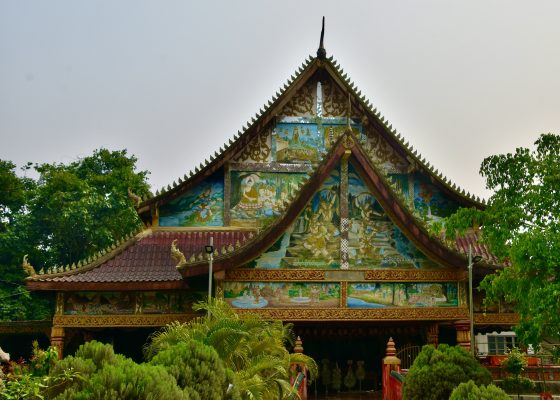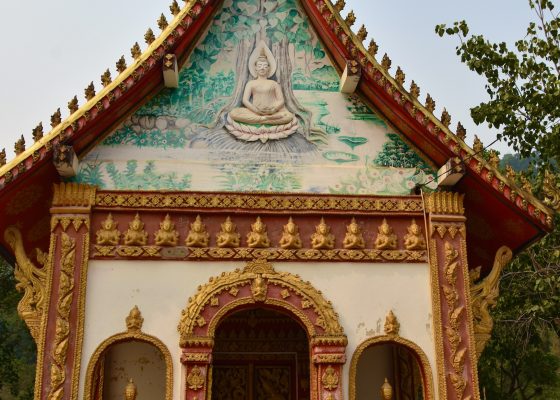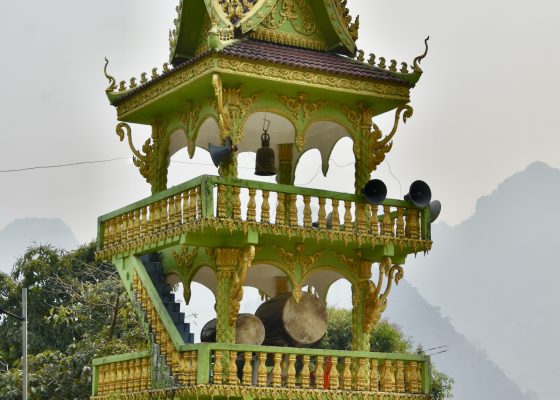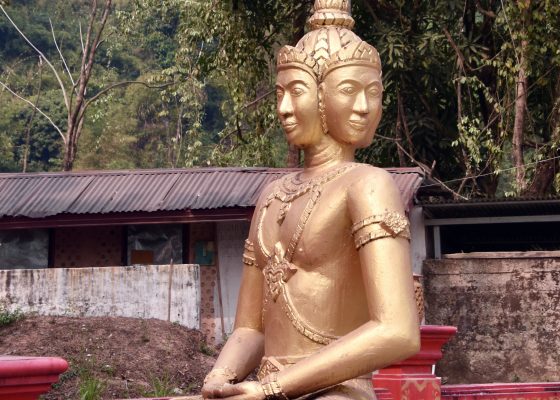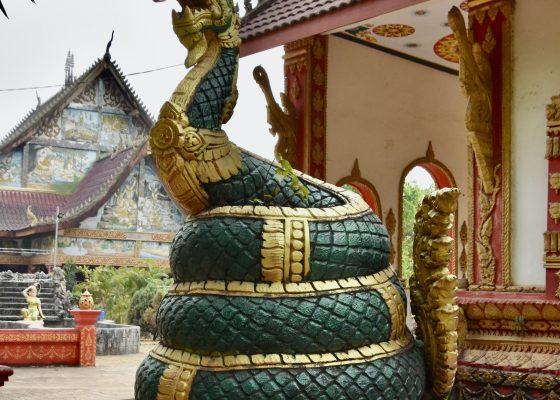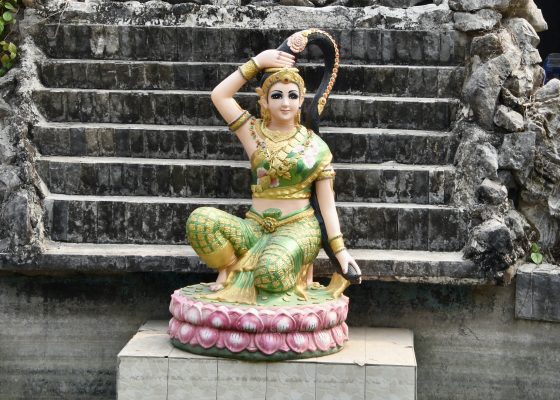Vientiane – Laos’ Surprising Capital City
In the last post from our trip to Laos with Adventures Abroad we visited the mysterious Plain of Jars and learned about the aerial bombardment the area endured during the Vietnam War that still has repercussions to this day. In this post I’m going to consolidate the last two days of the trip into one post for simplicities sake. The penultimate day involved a lot of driving with only a few stops of note before arriving at the small city of Vang Vieng. The next day we reached the capital city of Vientiane which is a francophone version of Viangchan, the Laotian name for the city. In this post I’ll stick with western version if only to get better search engine results. What we found in Vientiane was a complete contrast to anything else we had seen in Laos; a modern, bustling city of over a million inhabitants, but at the same time a city with deep religious roots. So with that short introduction let’s begin the final two days of our Laotian adventure.
Here is a map of the route from Phonsavan to Vang Vieng and then onward to Vientiane. It doesn’t look like it should take a day to get from Phonsavan to Vang Vieng, but trust me with the state of the roads in Laos it did.
On the way out of Phonsavan our local guide Ta had the driver stop at place where the vendors were selling fresh oranges, something we had not seen so far. They were a welcome treat.
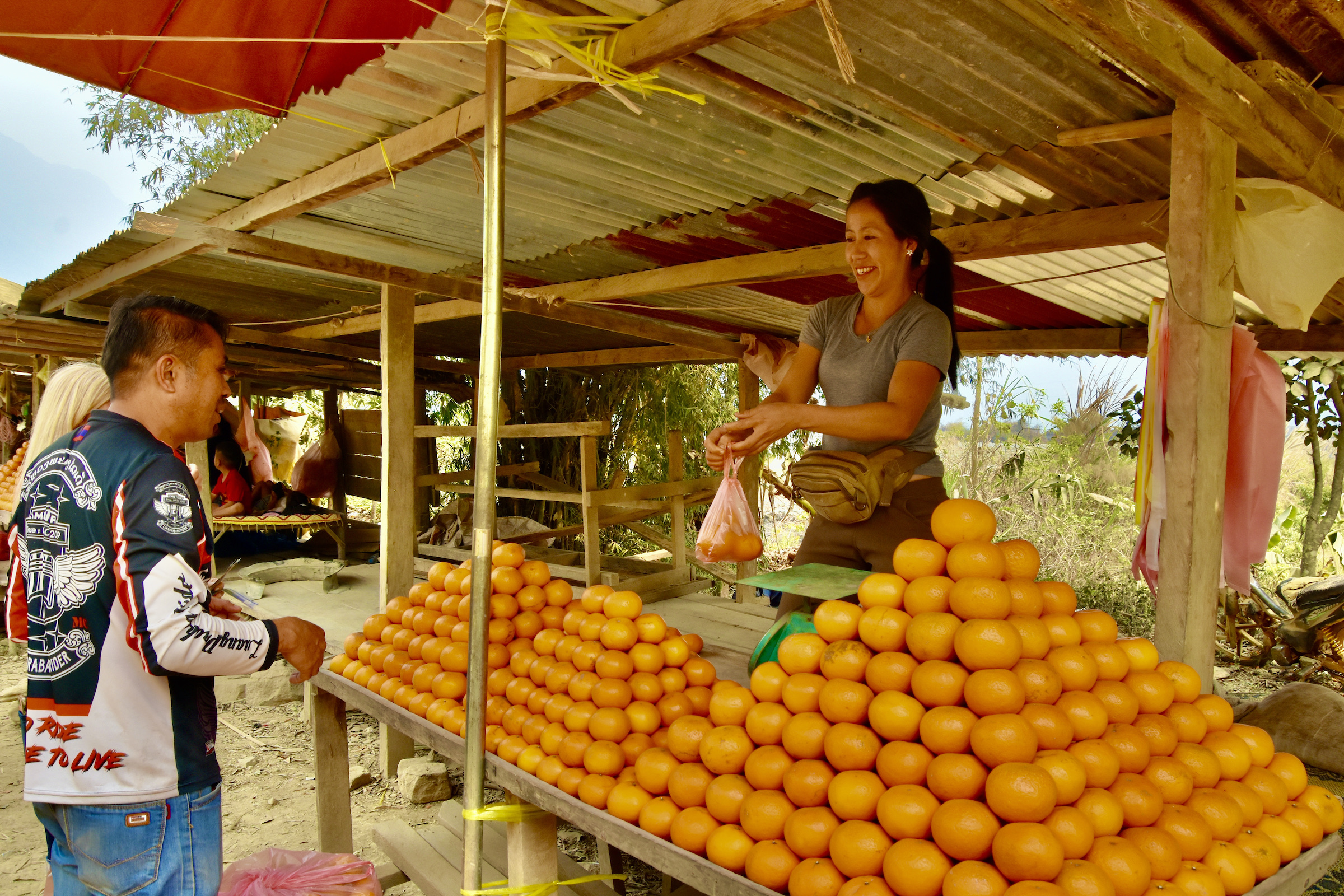
After a long stretch that saw us take hours to get back to the main Luang Prabang-Vientiane highway at Phou Khoun, we stopped for lunch and a well needed chance to stretch our legs. Hopes that the highway would improve as we headed south were just pipe dreams. What did improve however was the scenery, particularly as we got closer to Vang Vieng. The itinerary had promised an interesting karst topography and it did materialize, albeit somewhat difficult to see in the perpetual haze caused by the slash and burn agriculture.
Wat Pho Karm Chai Mong Kol
Our most interesting stop of the day was at a Buddhist temple complex on the banks of the Nam Song River, Wat Pho Karm Chai Mong Kol about which I can find next to nothing about on the internet. We reached it by climbing these stairs with the colourful balustrade.
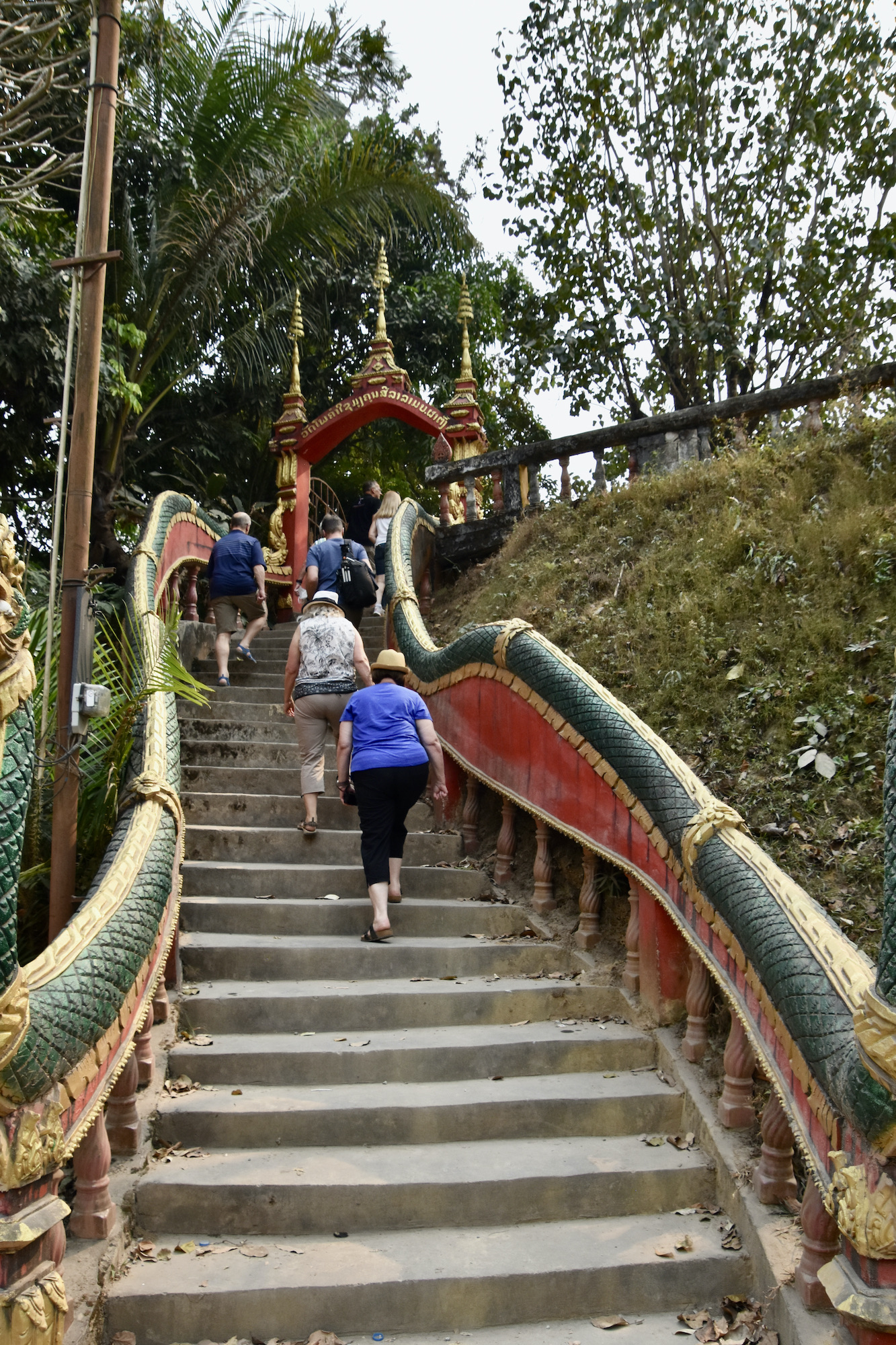
The complex consisted of a large and a small temple, a bell and gong tower and a number of interesting statues including a three faced-Buddha which I believe represents the three modes or essences of the Buddha’s existence. I’ve incorporated these photos into this small gallery. Double click twice to see each one enlarged.
- Wat Pho Karm Main Temple
- Smaller Temple
- Bell and Gong Tower
- Three Faces of Buddha
- Naga
- Female Guardian
At the entrance to the main temple there was this display made entirely out of lotto tickets.
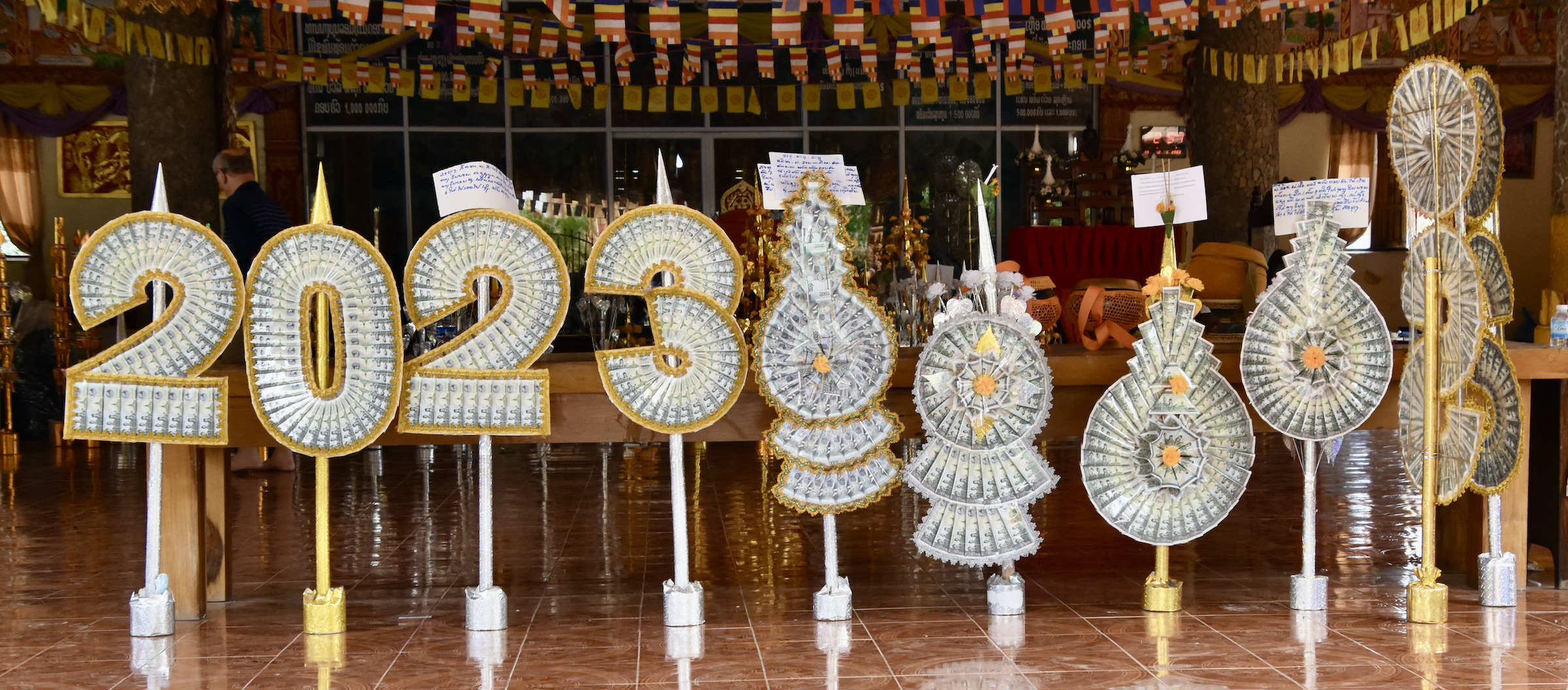
Just below the Wat Pho Karm Chai Mong Kol complex is the Pha Tang Bridge over the Nam Song River which we had time to walk across and watch the kids swimming and tubing in the river below.
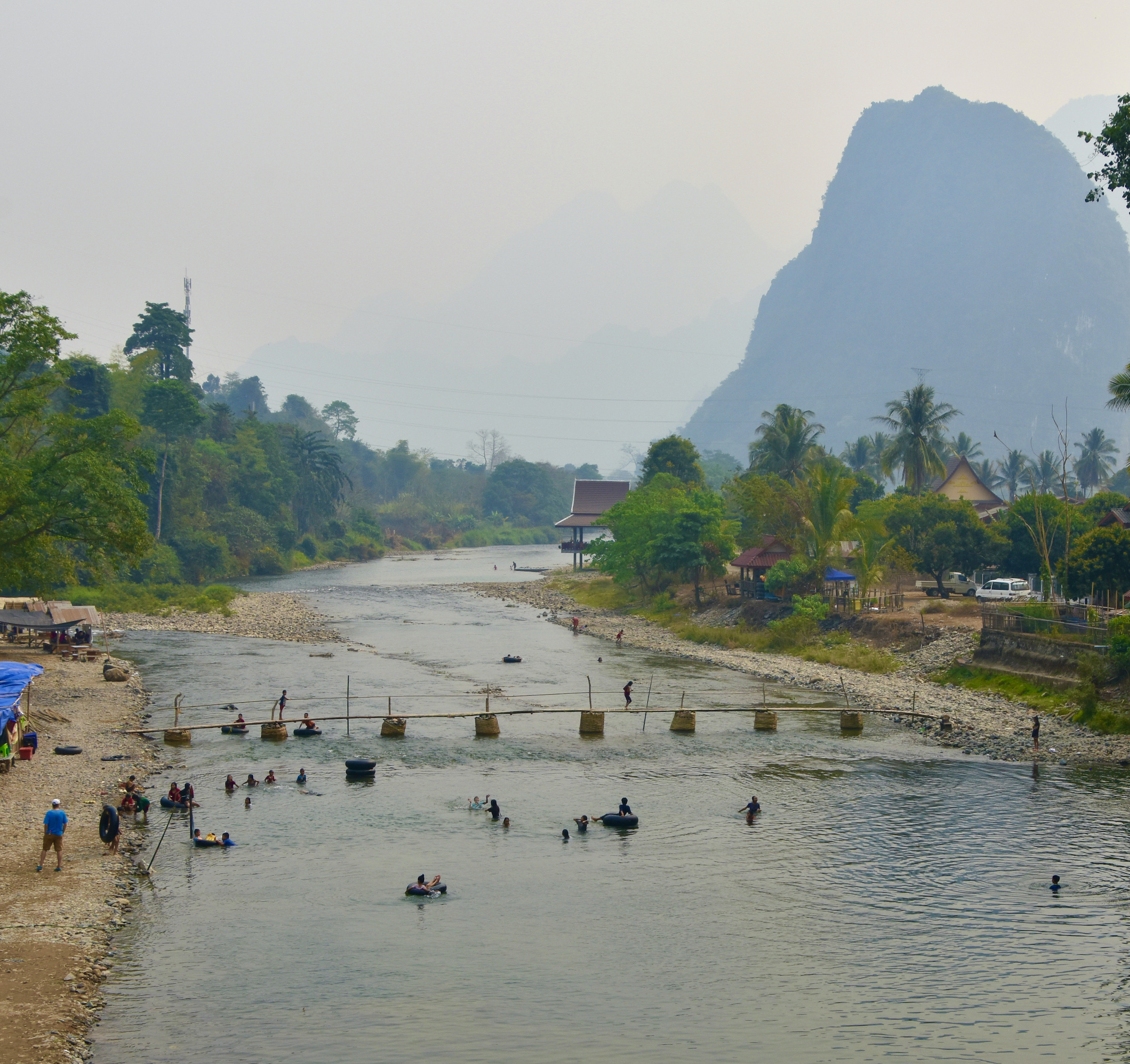
I decided to take a closer look. Laos may be one of the poorest countries in Asia, but don’t tell that to these kids who were having a ball.
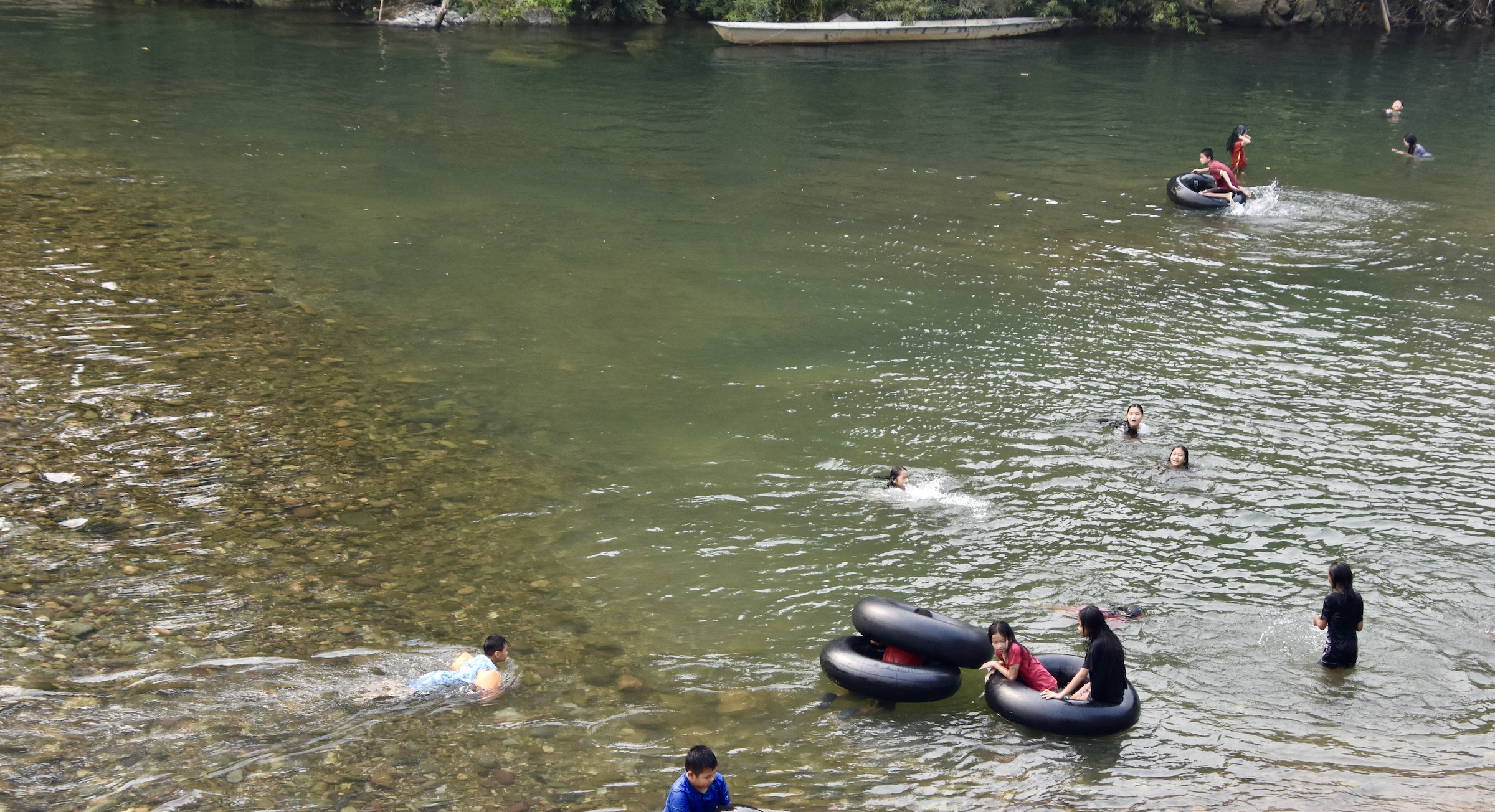
Looking directly down into the river from the bridge I could see schools of fairly large fish below. Not sure what they were, but I’m sure our AA guide Claude Morency, who is a fishing nut, would have wished for a chance to get out his rod and reel which is a permanent fixture in his kit bag.
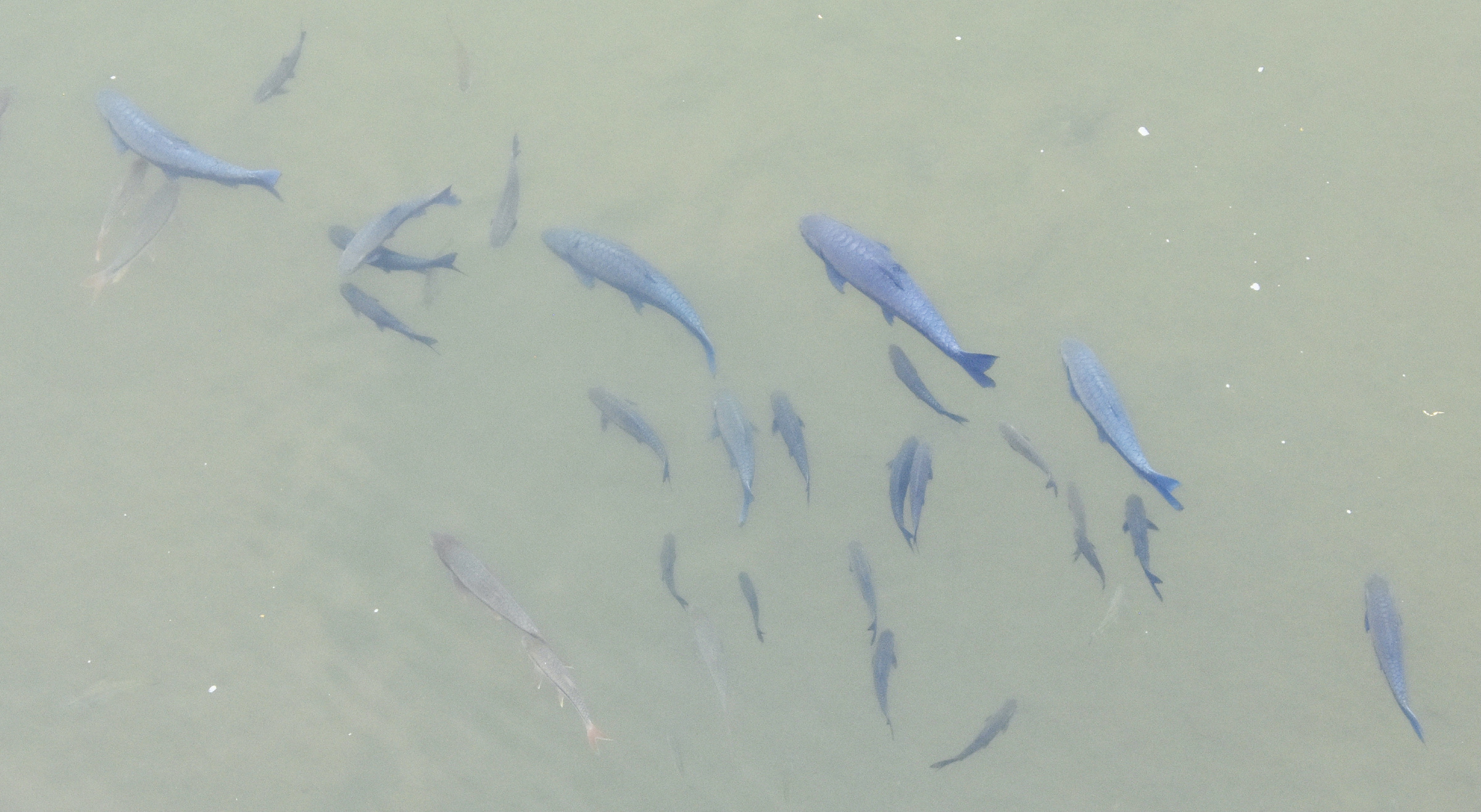
We arrived in Vang Vieng, which has a nice location on the Nam Song river, with enough time to do some relaxing around the pool at the Amari Vang Vieng hotel. After the battering the Laotian roads had delivered the previous two days it was a welcome respite.
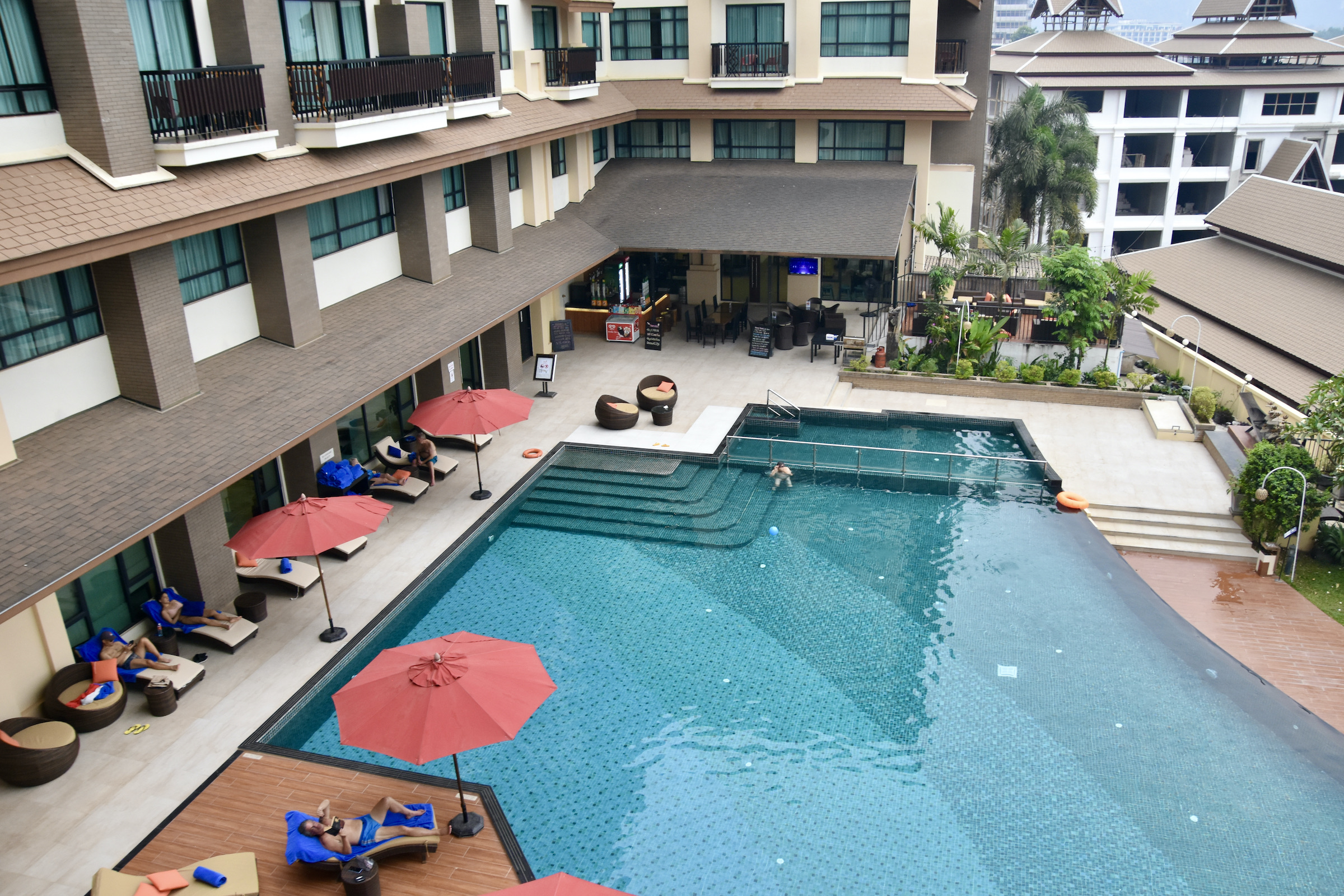
The next day we had a pleasant surprise – the highway between Vang Vieng and Vientiane was an expressway, the first in Laos. Opened in 2020 it is the only portion of the proposed Vientiane to Boten expressway on the Chinese border that has been completed. We covered the distance to Vientiane in 1.5 hours as opposed to the four hours + it would take following the old road and arrived in the city ready for a full day of touring.
Vientiane
As I’ve noted in previous posts from Laos, the Lao and Thai people were relative latecomers to Southeast Asia arriving from China over an extensive period beginning in about the 12th century. By then there had already been Mon and later Khmer settlements on the Mekong River near the site of the present city for hundreds of years. The name Vientiane did not emerge until the mid 12th century and it did not become an important city for another 200 years when the Lan Xang kingdom came into being, ushering in Laos ‘golden era’ as the Land of a 1,00,000 Elephants. in 1563 it was made the capital city of that kingdom and remained so until the empire disintegrated in 1707 after which it was an independent city state straddling both sides of the Mekong River. In 1779 the great Thai general Chakri, who later became Rama I, conquered the city and incorporated it into the Kingdom of Siam. He removed the famed Emerald Buddha to its current resting place in modern day Bangkok which we visited in this post. When the city rebelled in 1827 it was burnt to the ground by the Siamese and became a virtual ghost town until the French arrived in 1893. They made Vientiane the administrative centre of Laos, repaired many of the decaying monuments and built much of the modern infrastructure that serves the city today. Since 1975 it has been the capital of the Lao People’s Democratic Republic and while nominally communist you will see few of the trappings associated with places like Beijing and Pyongyang.
With that, let’s start our exploration of Vientiane starting with its most famous monument, the Great Stupa.
The Great Stupa Complex – Pha That Luang
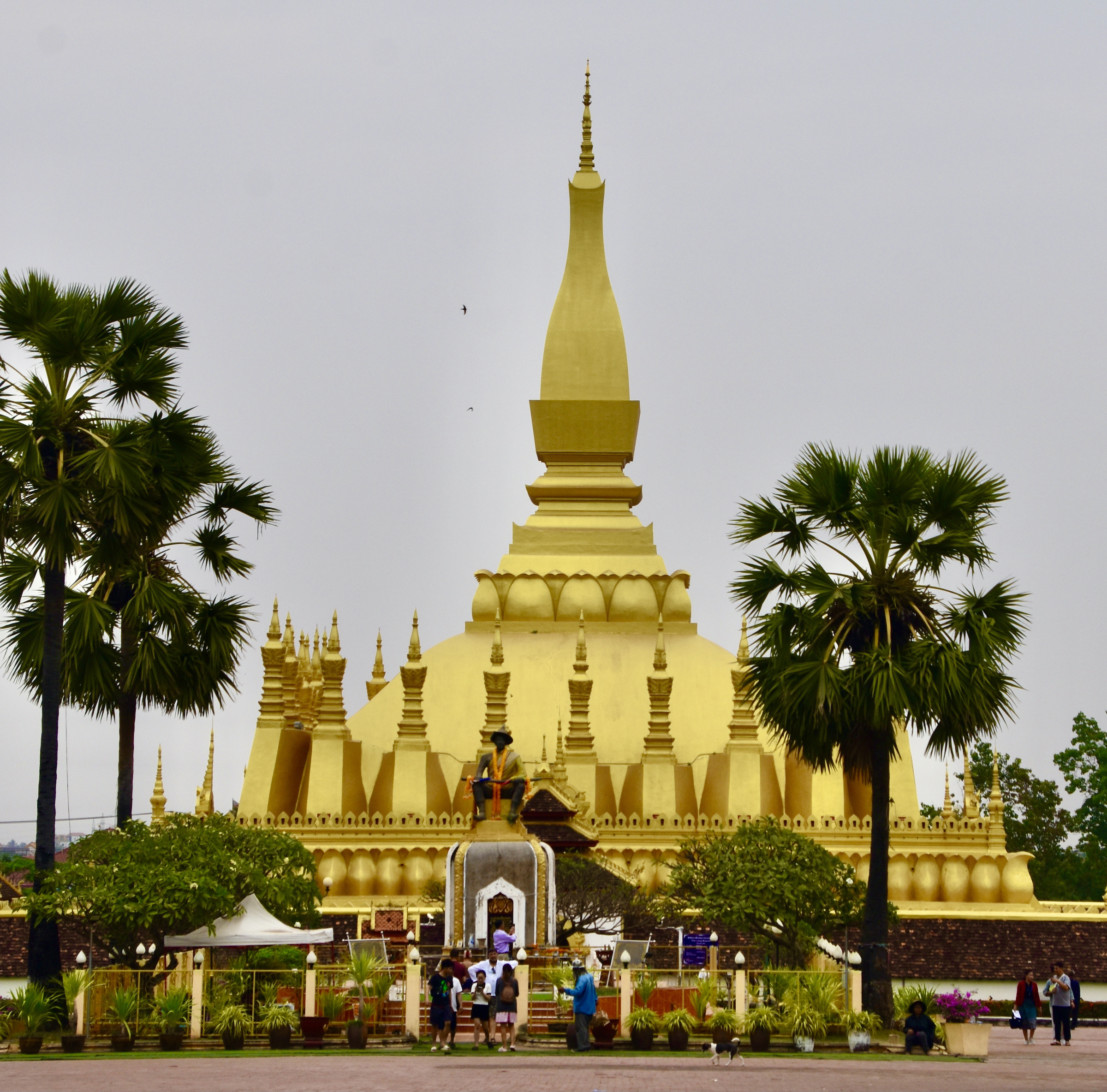
Our bus lets us out in the middle of a huge open area that provides for unobstrcted views of Pha That Kuang, the Great Stupa that is the national symbol of Laos, appearing on the currency and the Great Seal. There is a tradition that the first stupa was built here in the 3rd century to house some of those bones of Buddha that are as ubiquitous as pieces of the ‘true cross’. The Khmers did have a temple here before the Laos appeared on the scene, but it fell into disrepair. What we are looking at today originally dates from 1566 when King Setthathirat moved the capital from Luang Prabang to Vientiane. It was destroyed in the 1828 Siamese invasion and rebuilt by the French in the 1900s.
The man seated in front of the Great Stupa is fittingly, King Setthathirat.
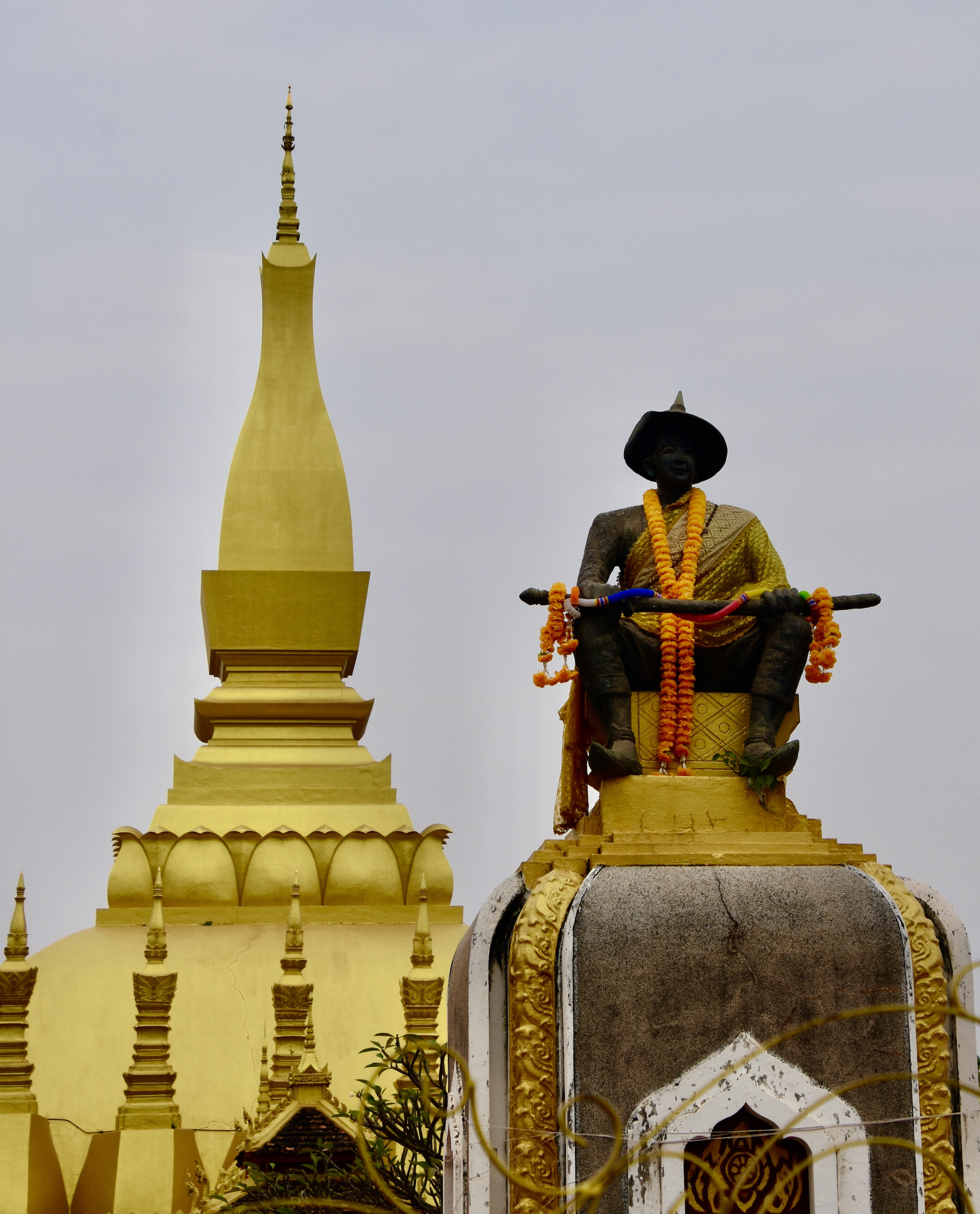
There is not much you can do but be somewhat awestruck by this monumental (in every sense of the word) structure other than take pictures of it.
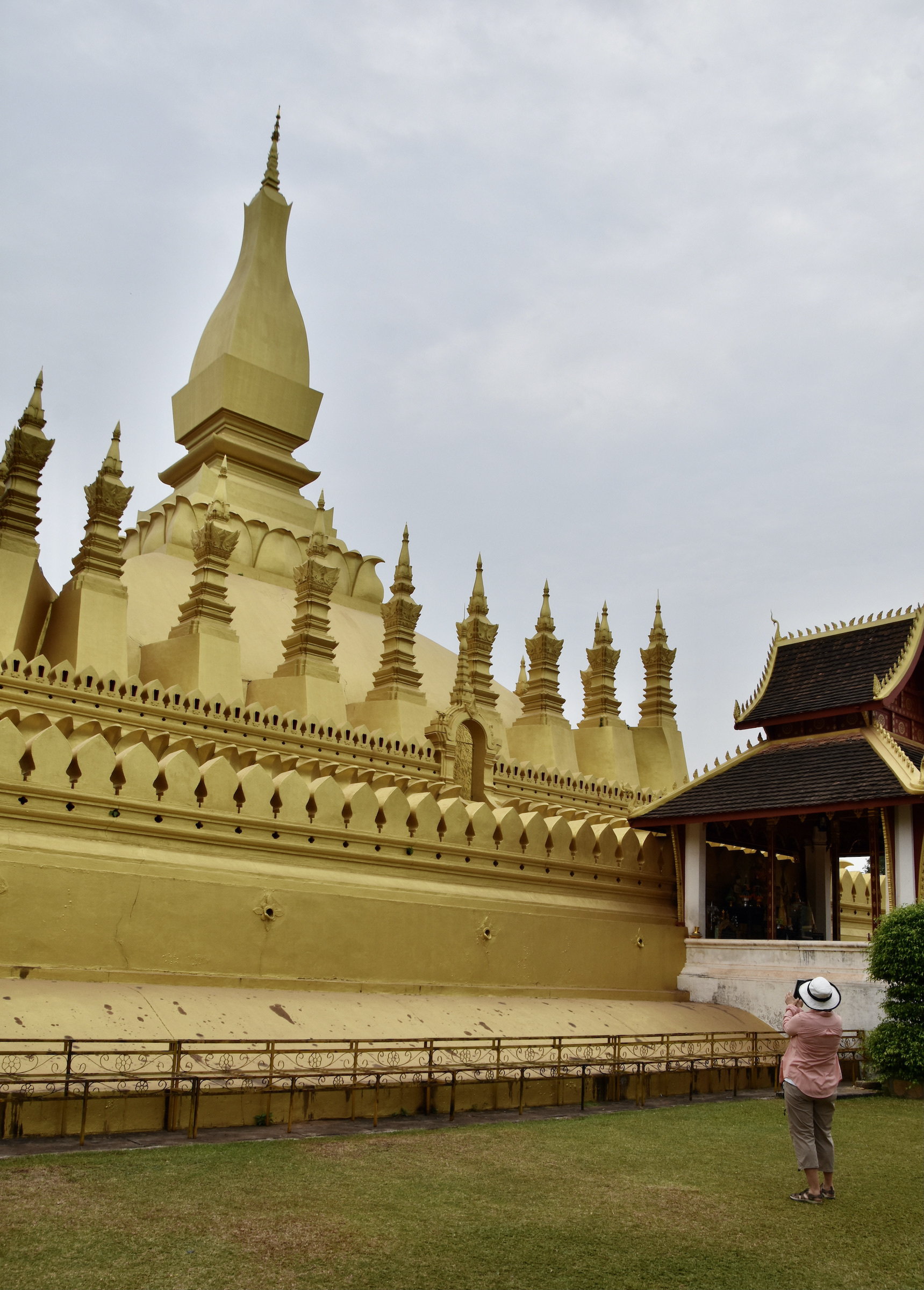
Looking up, way up as the Friendly Giant used to exhort, you see the pinnacle of the Great Stupa spire which is made of pure gold.
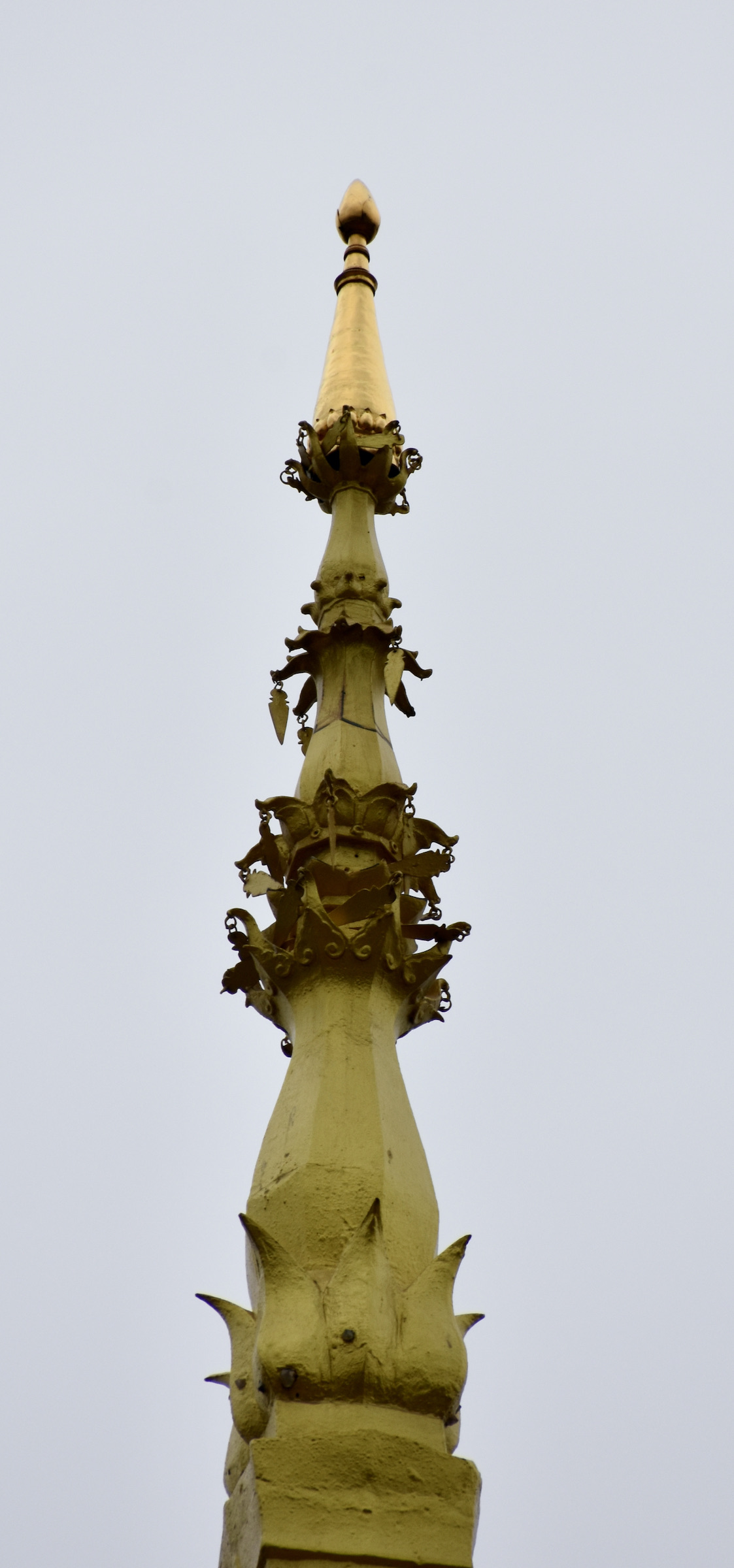
There are some interesting pieces to observe on a walk around the Great Stupa starting with this statue of King Jayavarman VII which dates back to the Khmer period and is thus much older than the stupa itself.
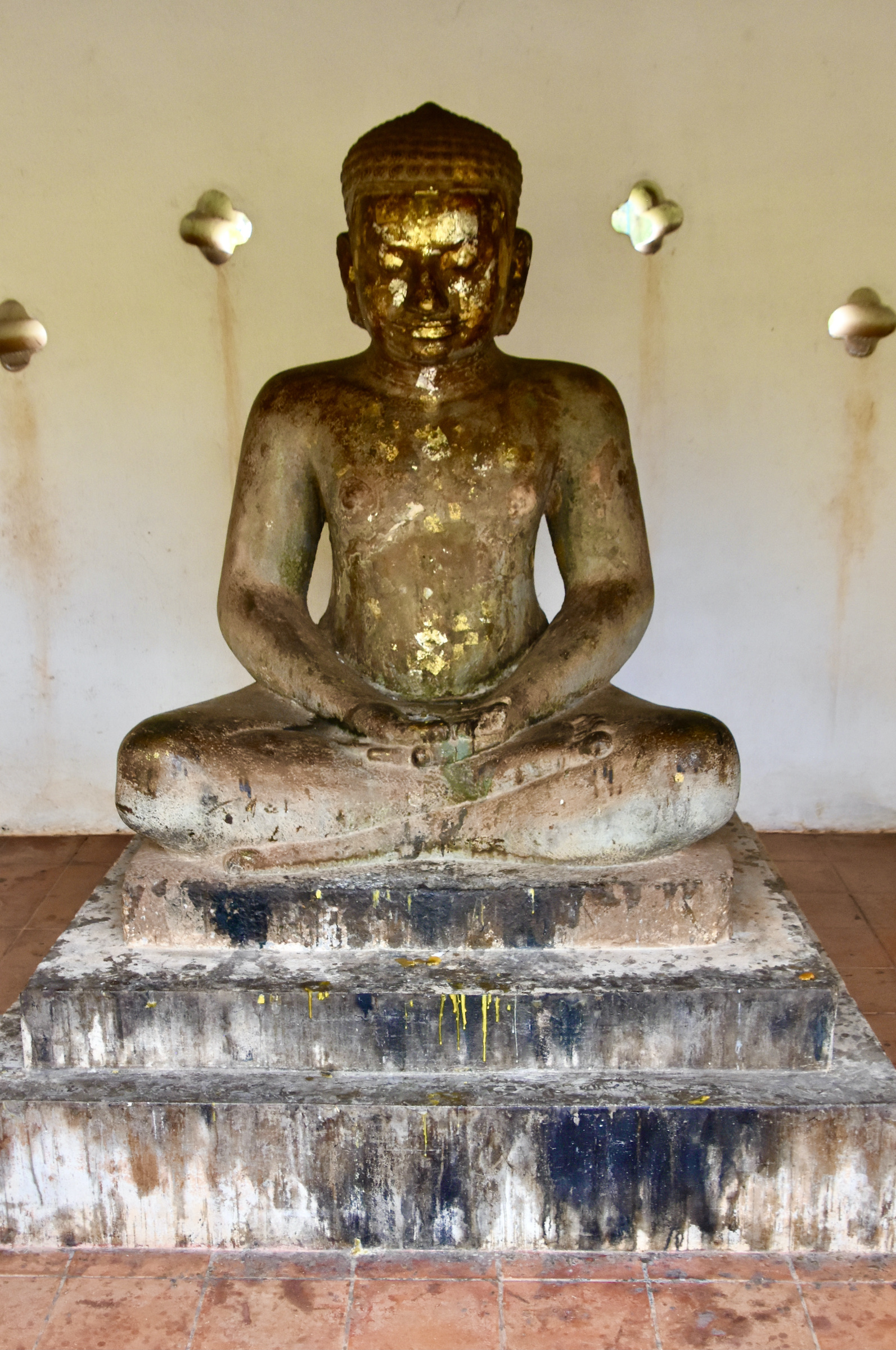
Also of note is this exquisite head of Buddha in bronze. While we westerners often think of the Greeks as the originators of cast bronze statues, in fact the Chinese, Indians, Sri Lankans and Khmers were all adept at it as well. The broad nose and lips suggests that this is a Khmer creation that somehow evaded the Siamese looters of the 19th century.
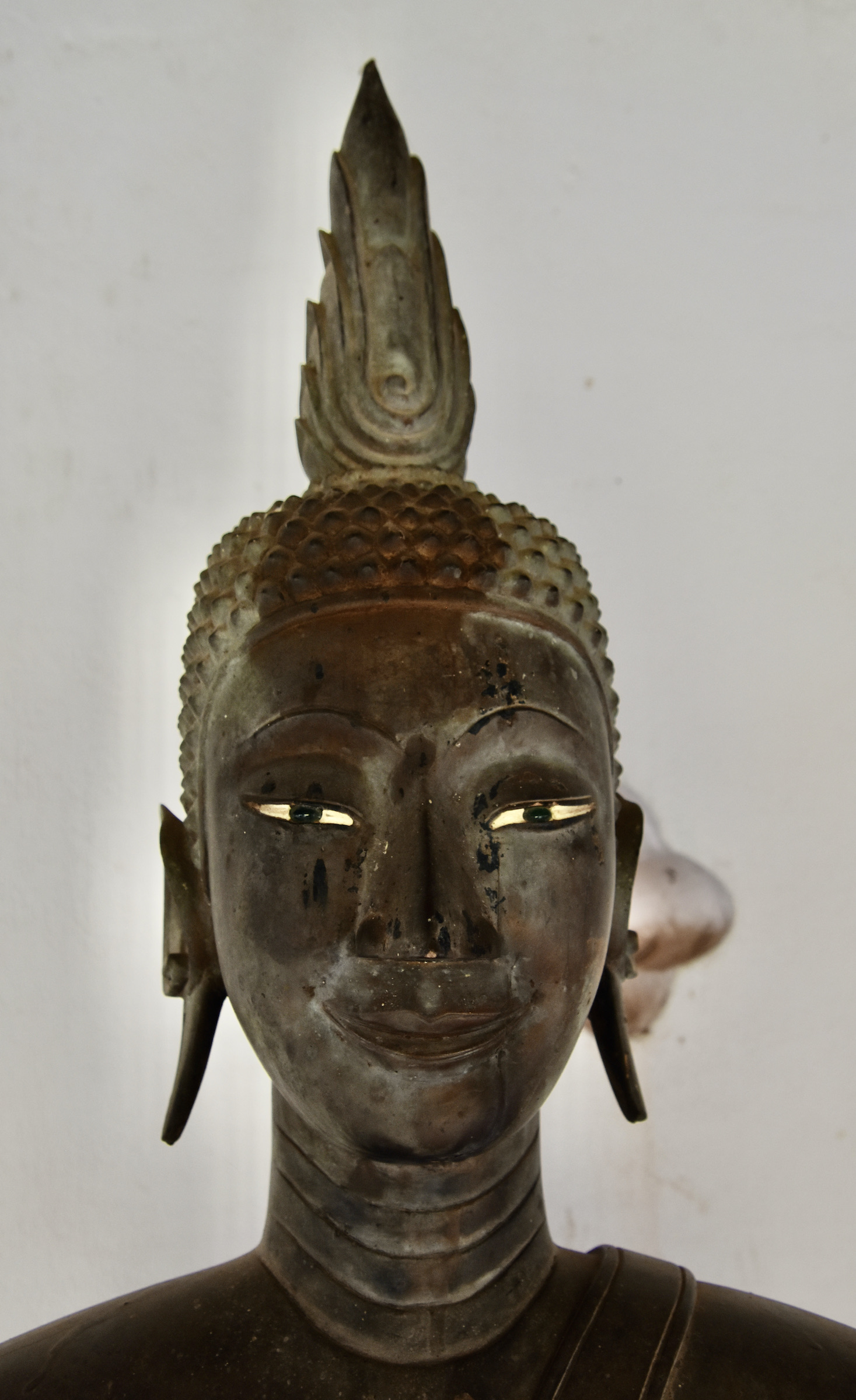
This fearsome looking naga guards one of the entrances.
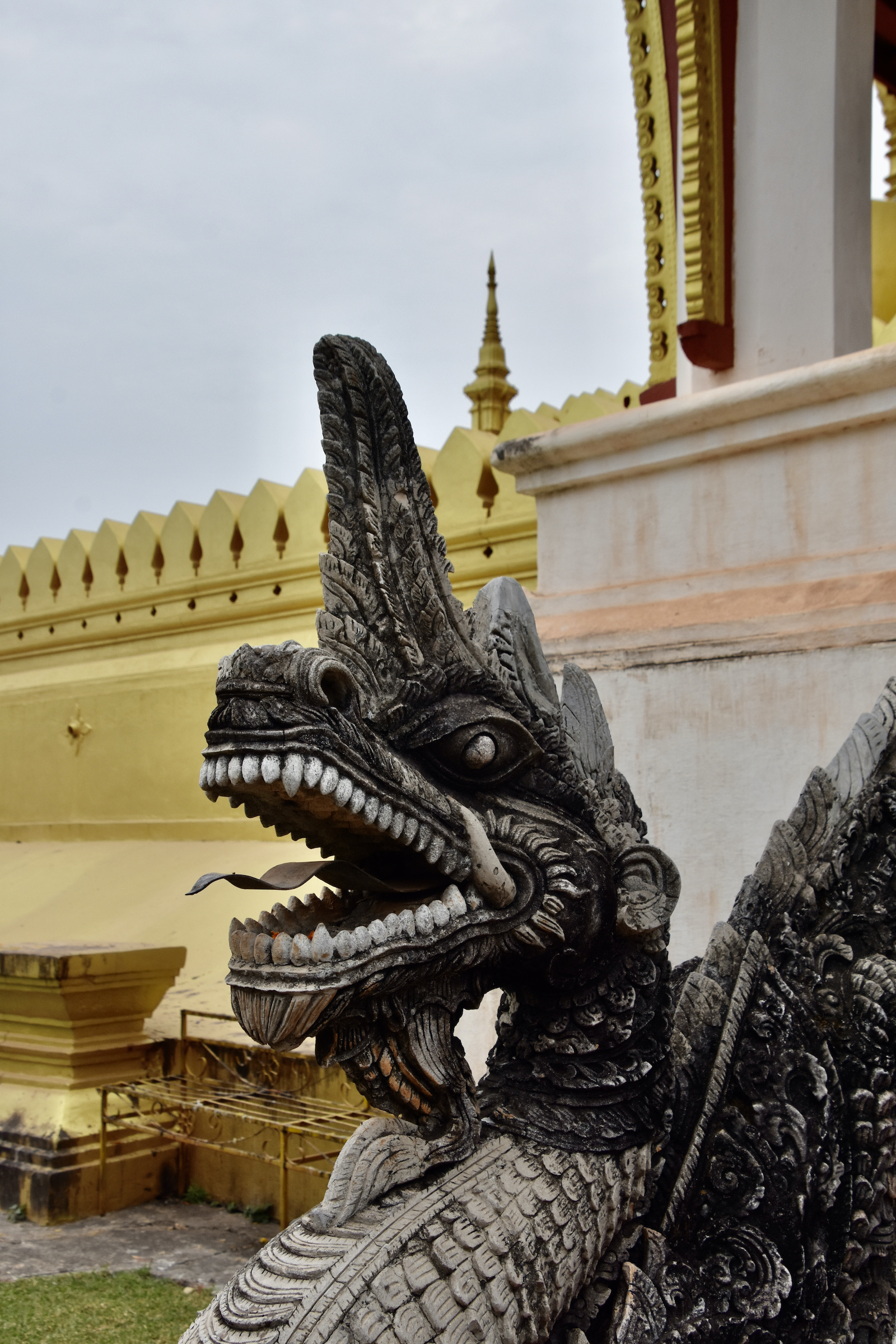
I’ve commented on this before, but the plaza in front of the Great Stupa is one of the better places to observe the kidnapped bird tradition commonly found near many Buddhist monuments. It is believed that if you free a trapped animal as the Buddha did, that it will bring you good luck. Sadly it’s become nothing more than a racket for dim-witted tourists. No sooner is the bird ‘freed’ than it is caught once again to be held for ransom until the next sucker comes along.
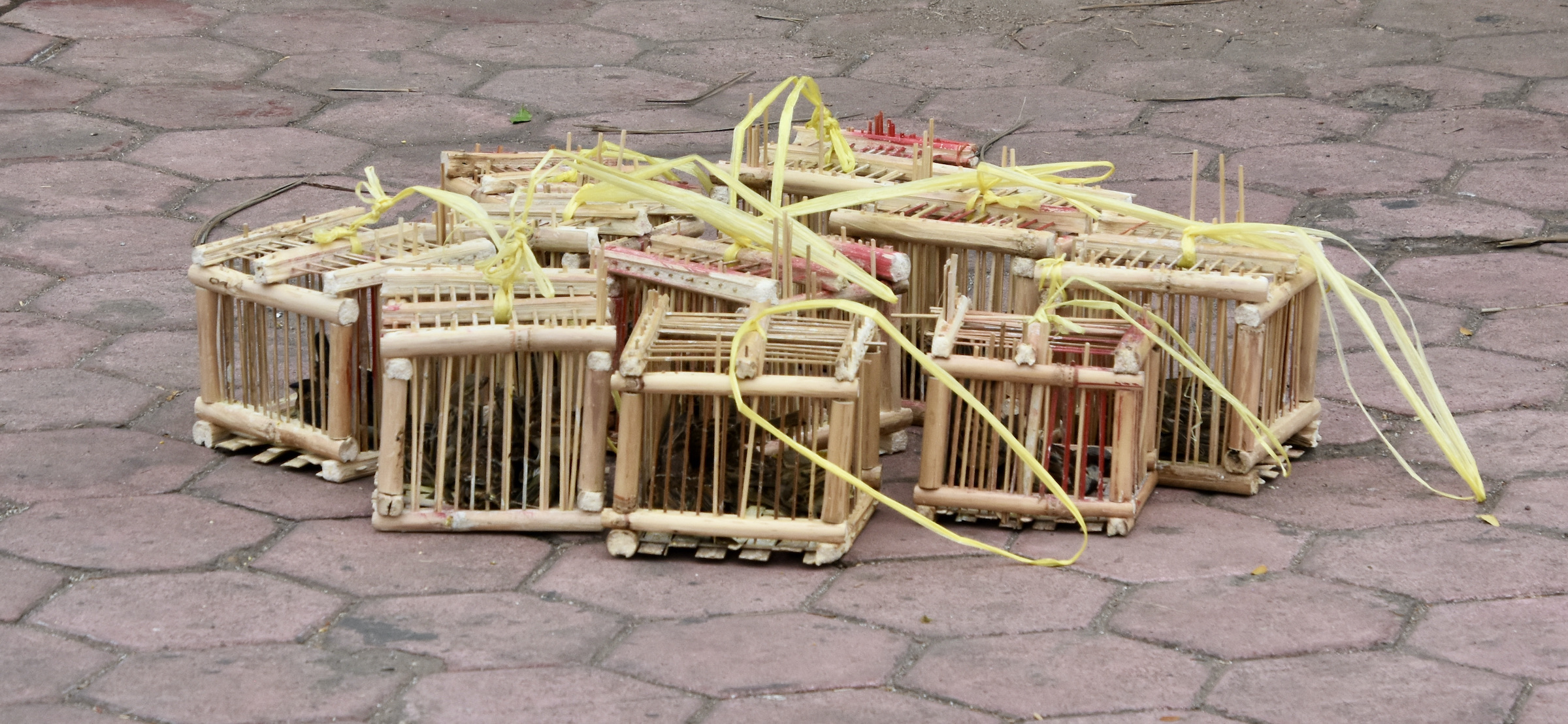
Wat That Khao
Right beside the Great Stupa in Vientiane is Wat That Khao which features this giant reclining Buddha, which presents the Buddha in his final moments as a living entity, having finally achieved enlightenment. Unlike Wat Pho which we saw in Bangkok, you can take in the entirety of this statue because it’s not housed inside a temple. Also there were a zillion less people here today than in Bangkok. You could actually enjoy the tranquility of these surroundings.
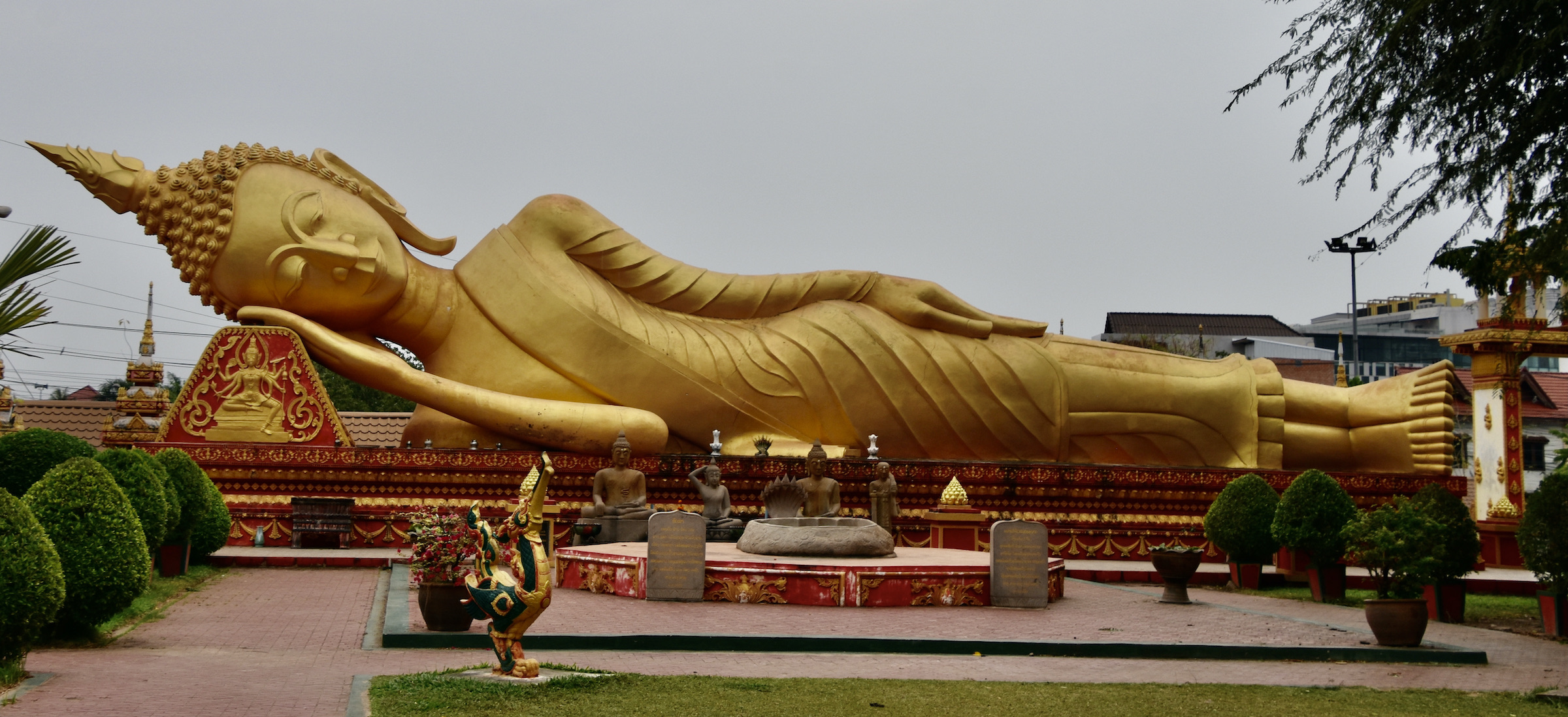
This is a replica of the Emerald Buddha that the Thais stole from Vientiane in 1828. We may have missed the real thing in Bangkok, but this at least gives us an idea of what it looks like.
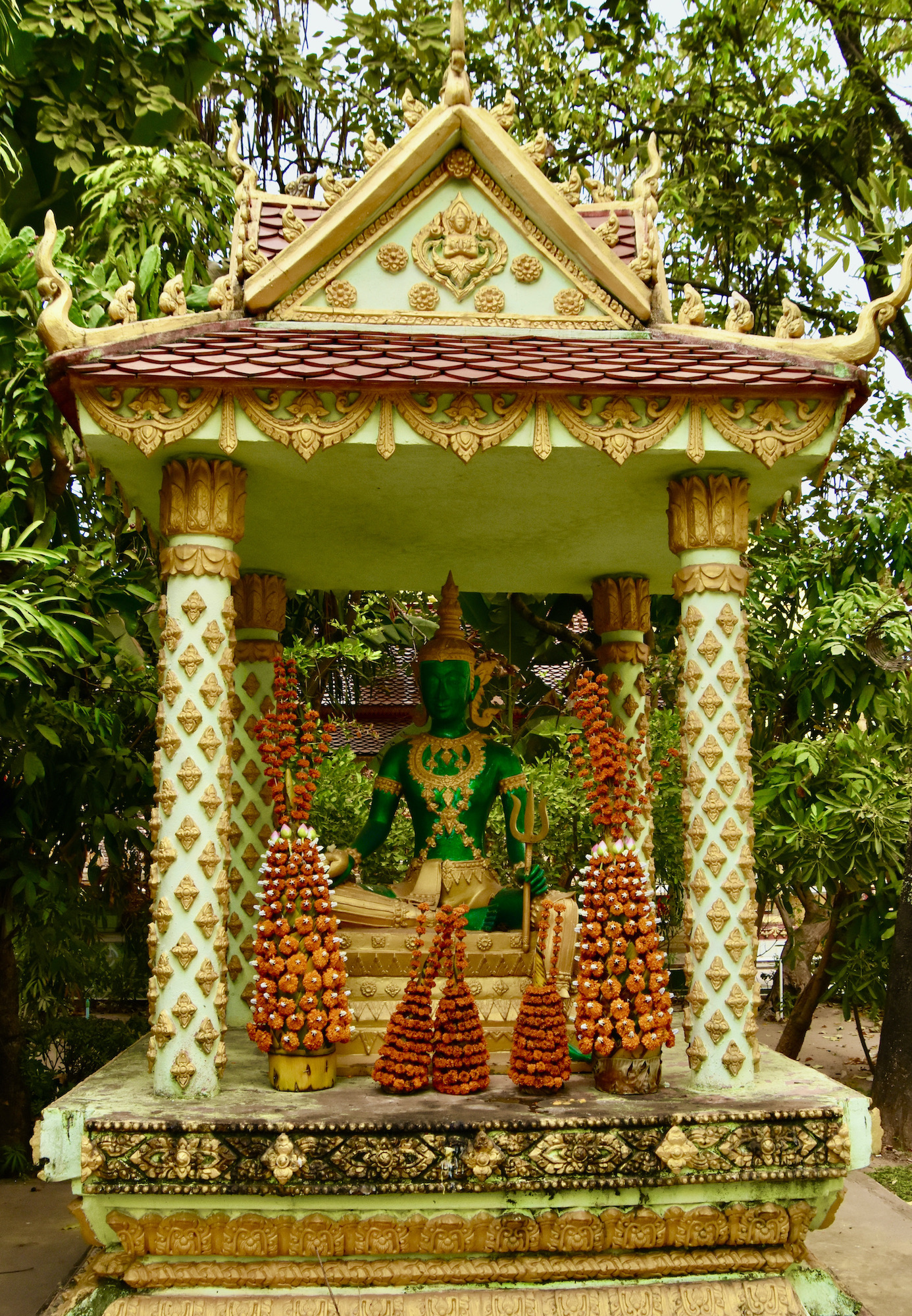
And this is Haw Pha Kaew the temple from which the Emerald Buddha was abducted by the Siamese in 1828. I wonder if the Thais will receive the criticism for not returning it that any western country would in similar circumstances?
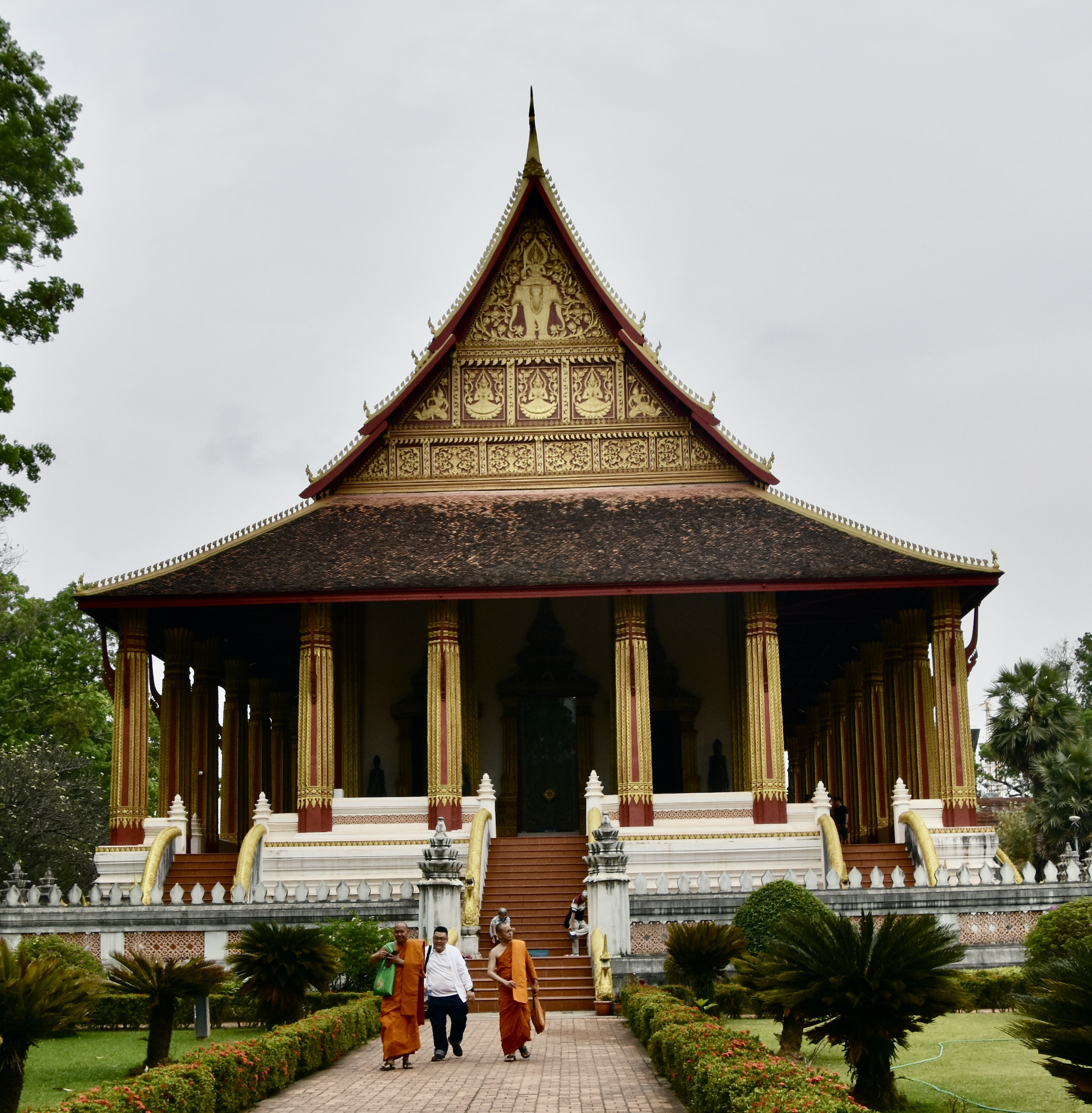
There must be a high demand for skilled painters in Buddhist and Hindu countries because keeping something as intricate as this piece as new and shiny as it looks today must take constant retouching.
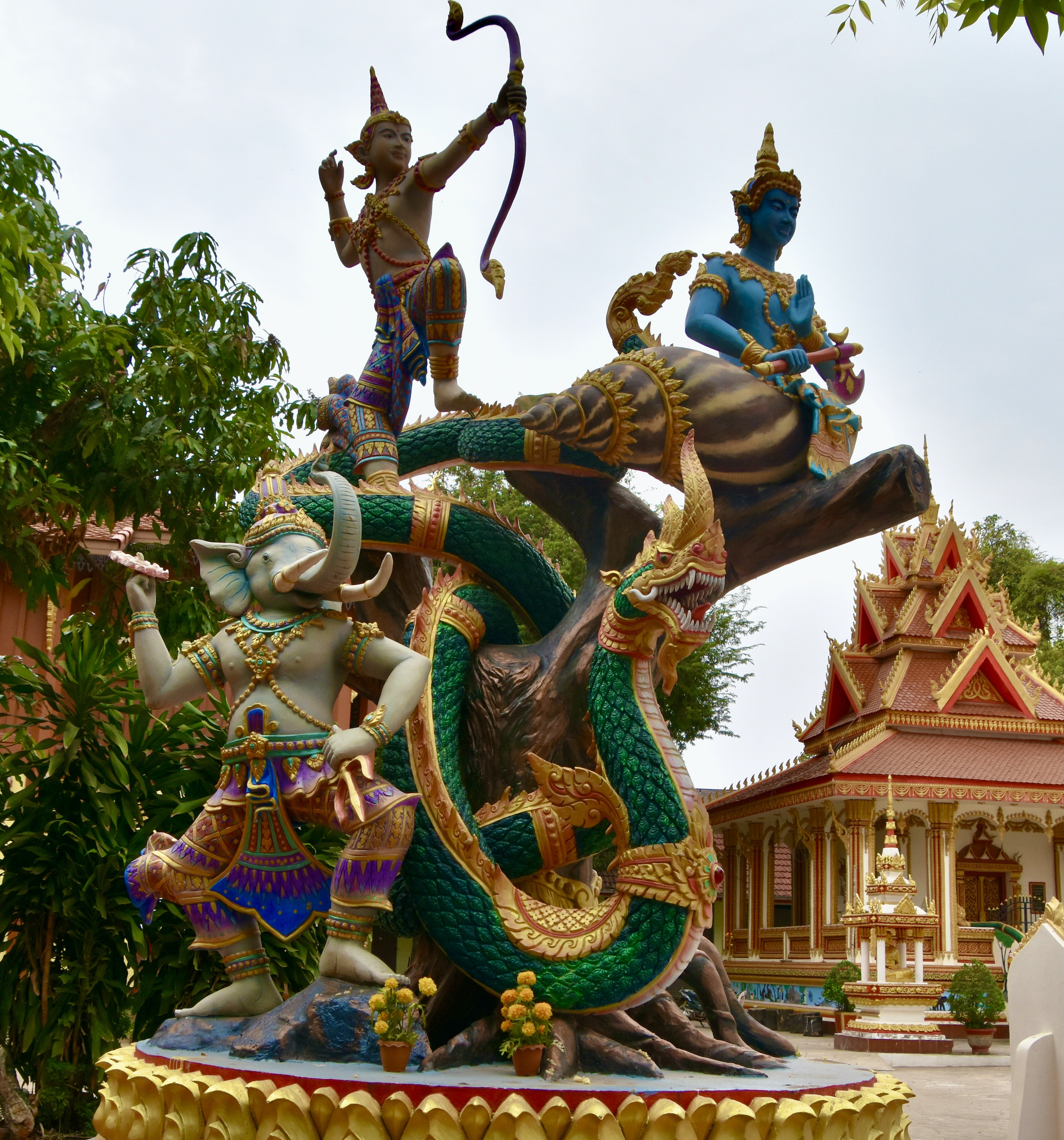
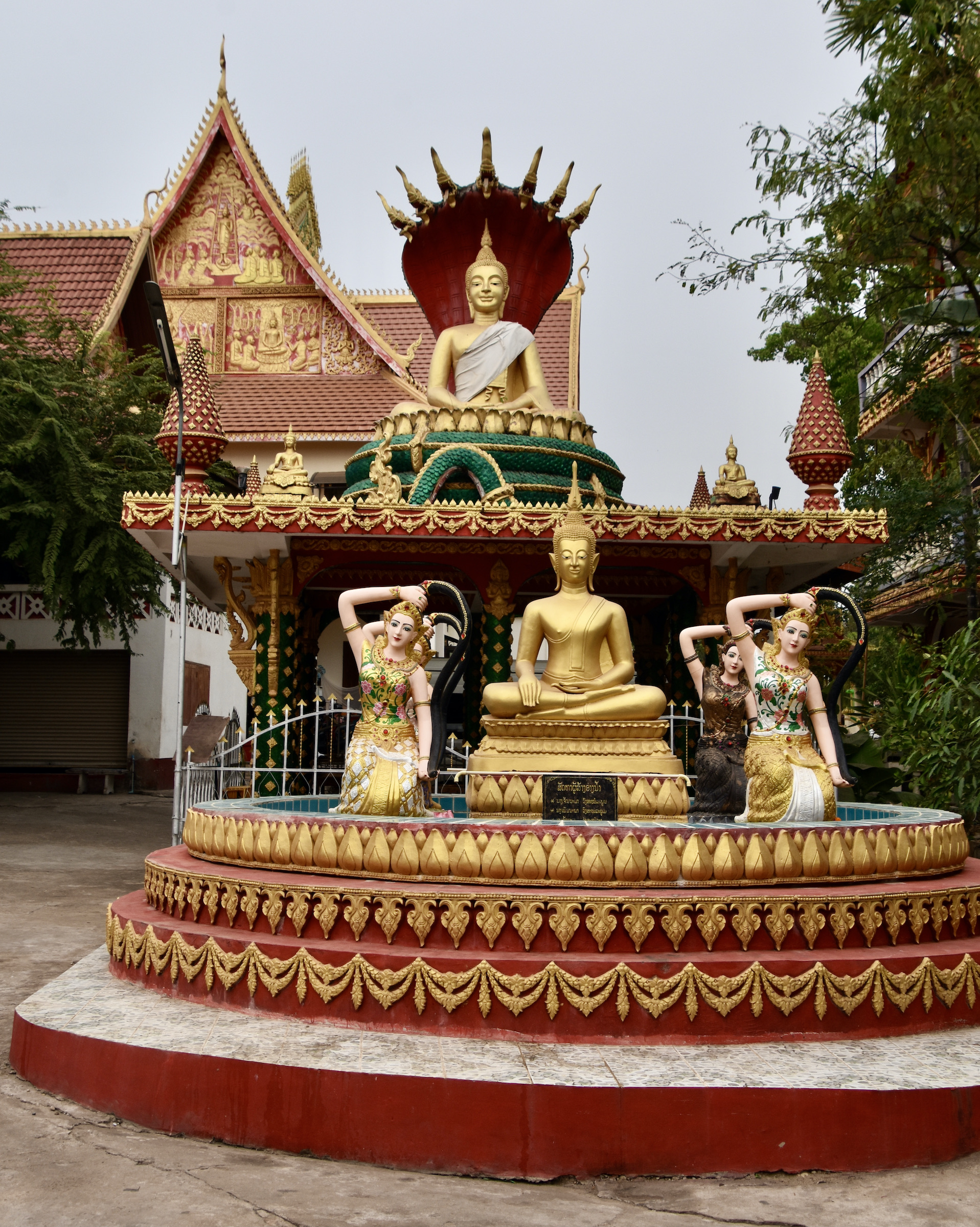
When we get to the next temple complex, Wat Si Muang things go seriously over the top with images that reminded me more of a visit to a second rate theme park than a religious complex. This is the entrance to a shrine to a pregnant woman who apparently let herself be sacrificed as a peace offering when the temple was first constructed in the 1500s.
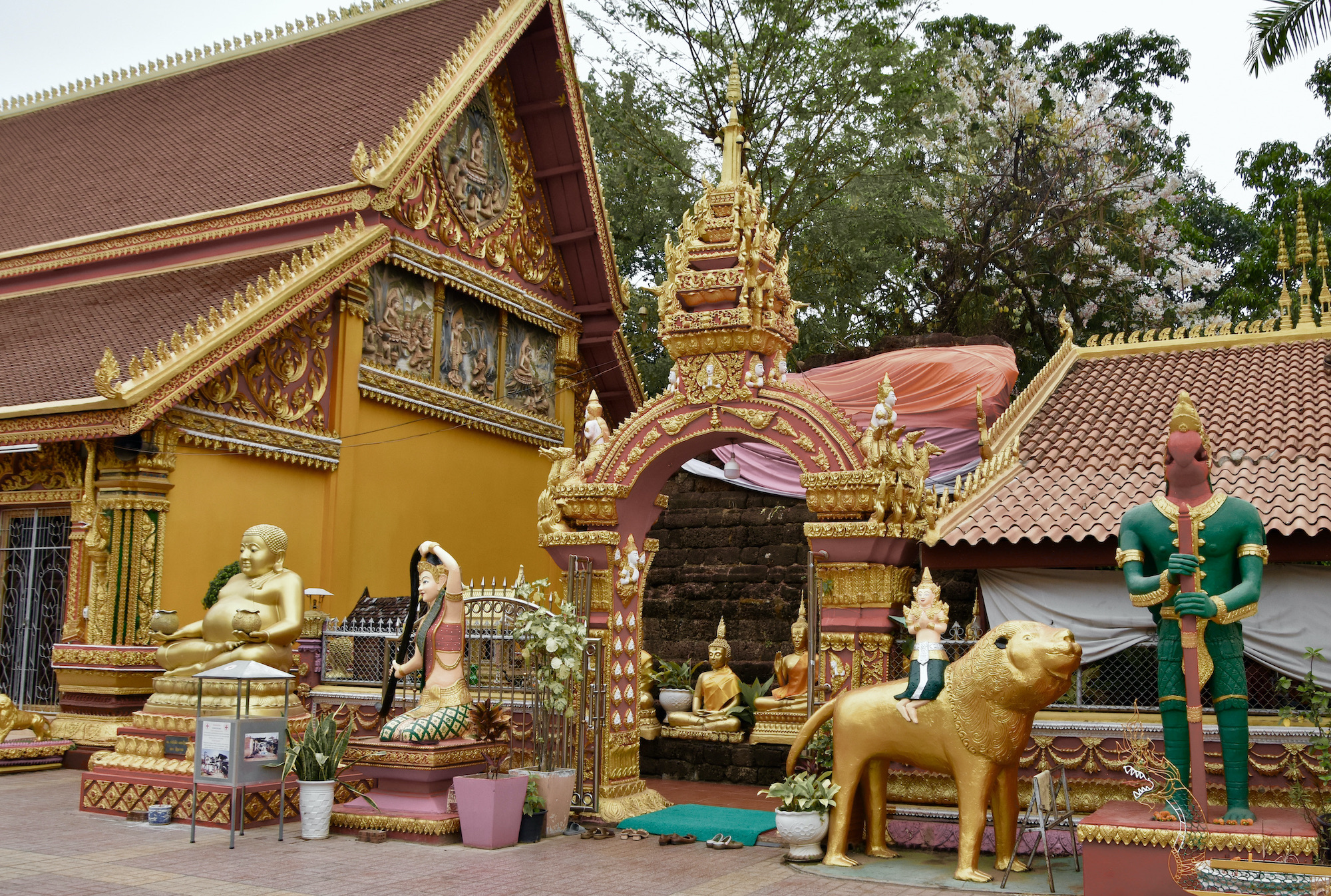
This is our group not really sure what to make of this place, but the temple itself is a beautiful structure that has been rebuilt numerous times.
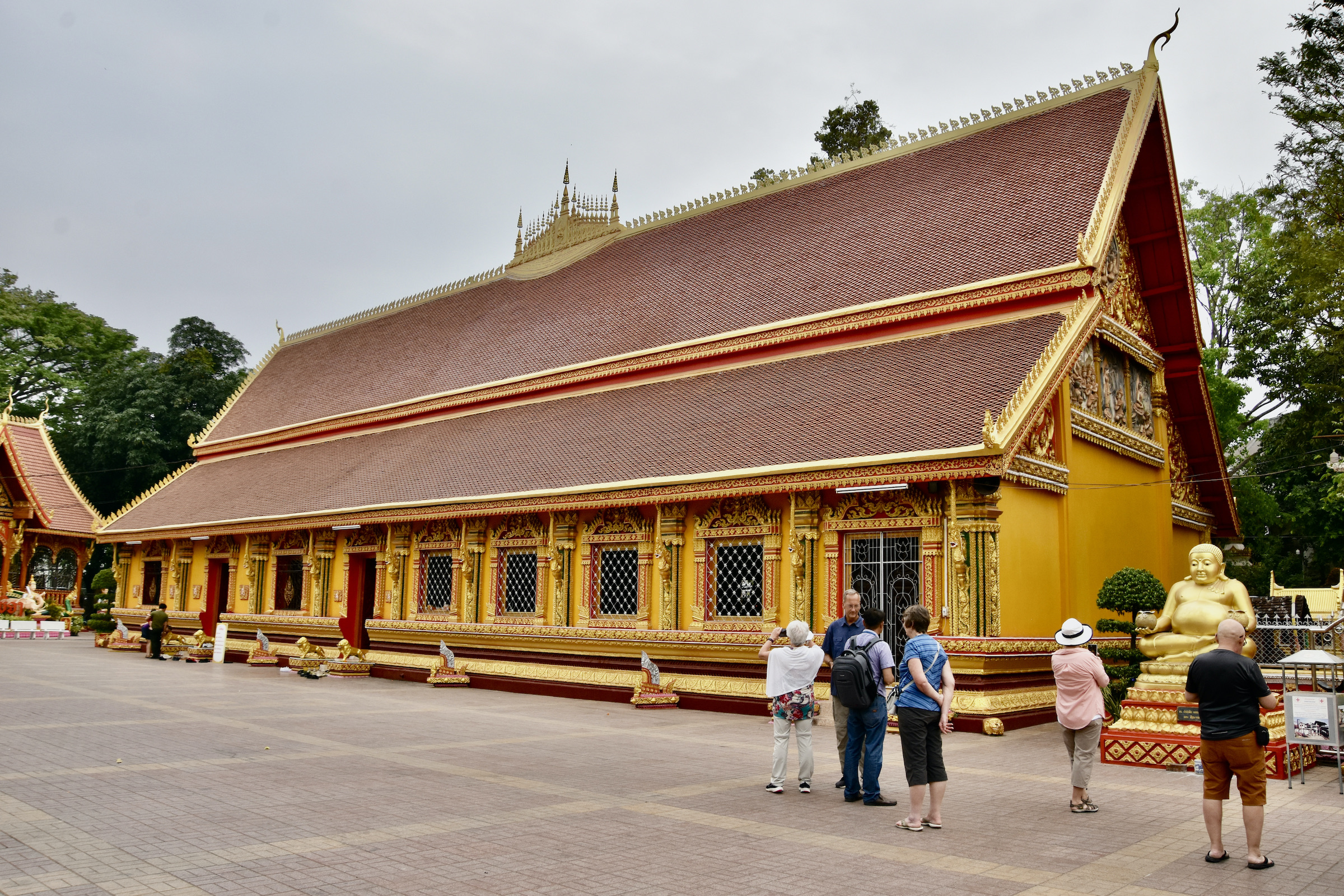
Just in case you were thinking of getting carried away with the carnival like atmosphere of Wat Si Muang this sign reminds you that this is no place for these type of antics. This truly is a case of a picture being worth maybe not a thousand words, but a lot compared to the written version.

Things do get more serious after we wrap up our visit to the historic temple area of Vientiane which sounds kind of oxymoronic because we were visiting religious places after all. But this next place is deadly serious.
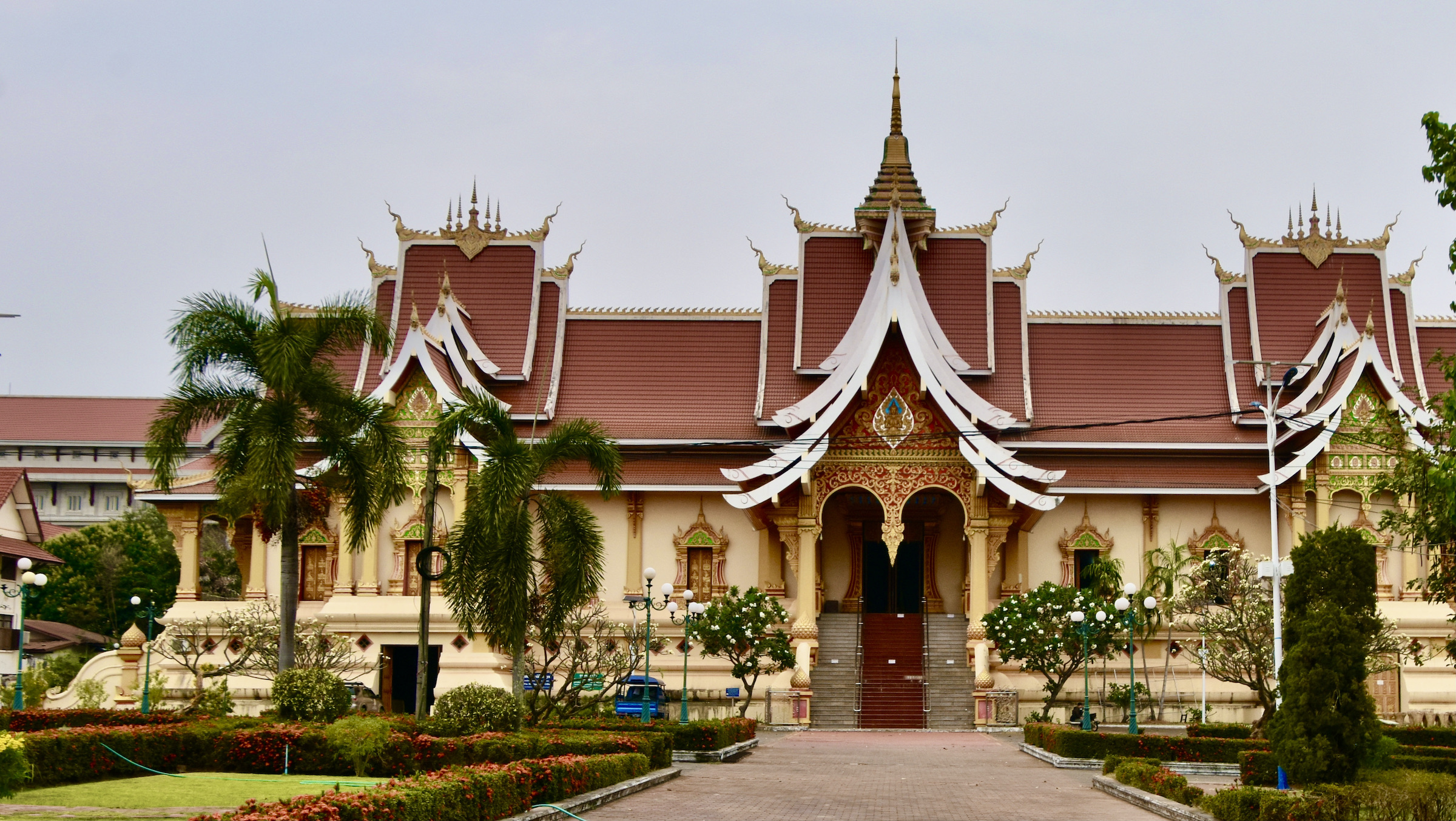
This is the headquarters of the Buddhist religion in Laos and technically I suppose the equivalent of the Vatican City or close to it in Vientiane. While it’s not a tourist attraction per se visitors are welcome to come inside as long as they are quiet and respectful. Some of us did and I was truly impressed by the scenes from the life of Buddha that covered a good portion of the walls.

The ceiling as well was very ornate and worth risking a crick in the neck to see.
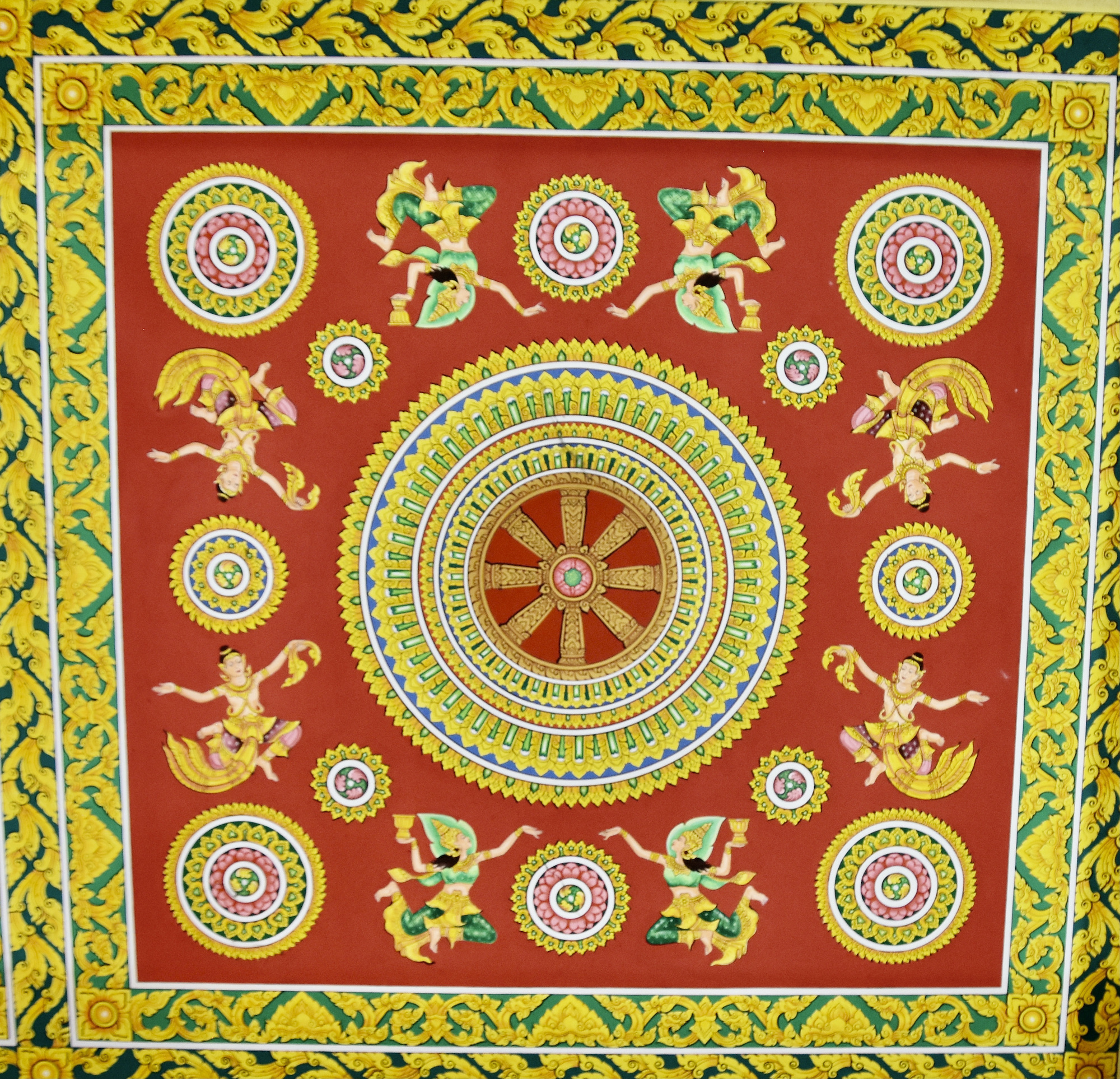
Others were templed out and ready to move on to some secular activities.
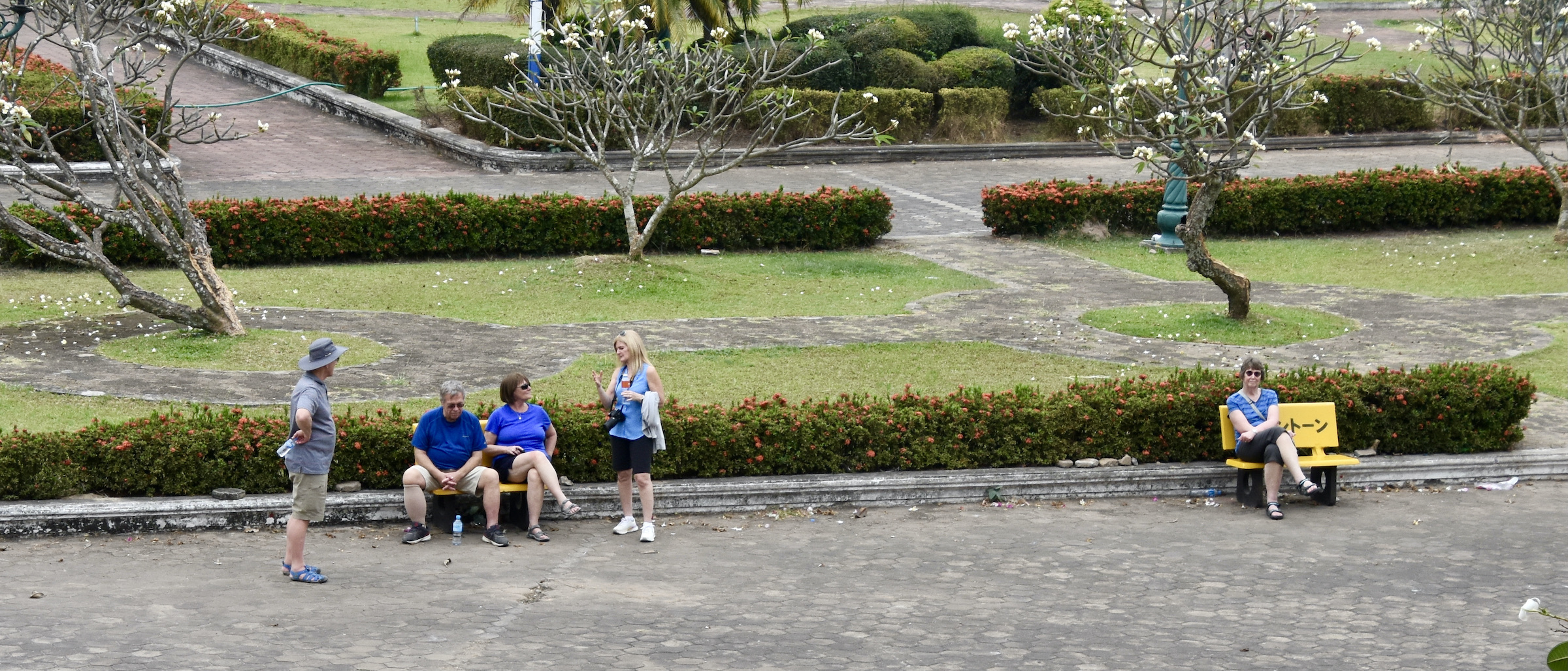
In the post from Phonsavan I commented on how good the sausages looked in the local market. Today for lunch I got to try some and they were delicious as were the fresh spring rolls. These latter are to be distinguished from the deep fried spring rolls we find on offer in most North American restaurants. Fresh spring rolls are a vegan’s delight and I’m not saying that facetiously.
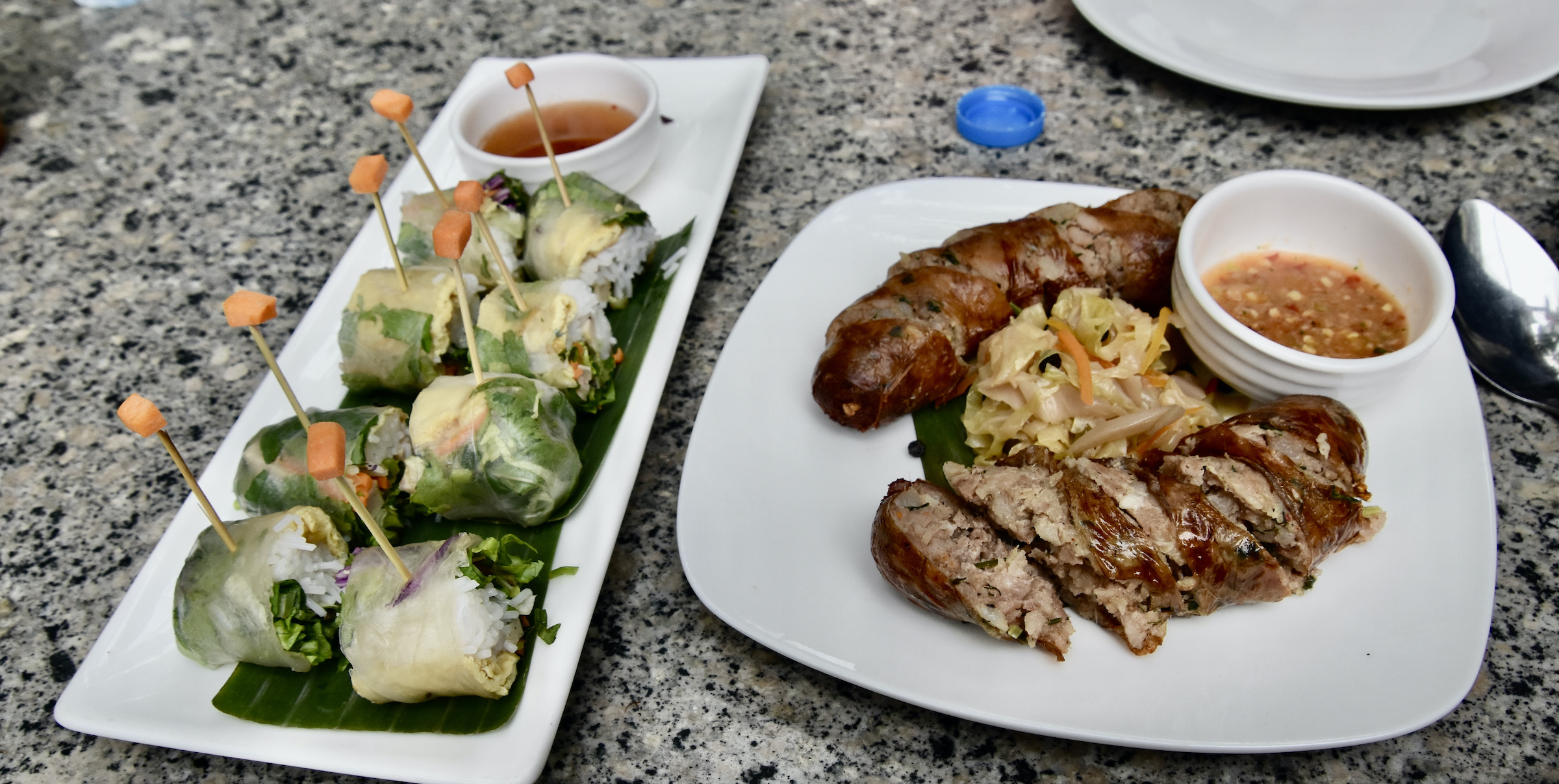
Washed down with a Lao draft you have the makings of a great lunch.
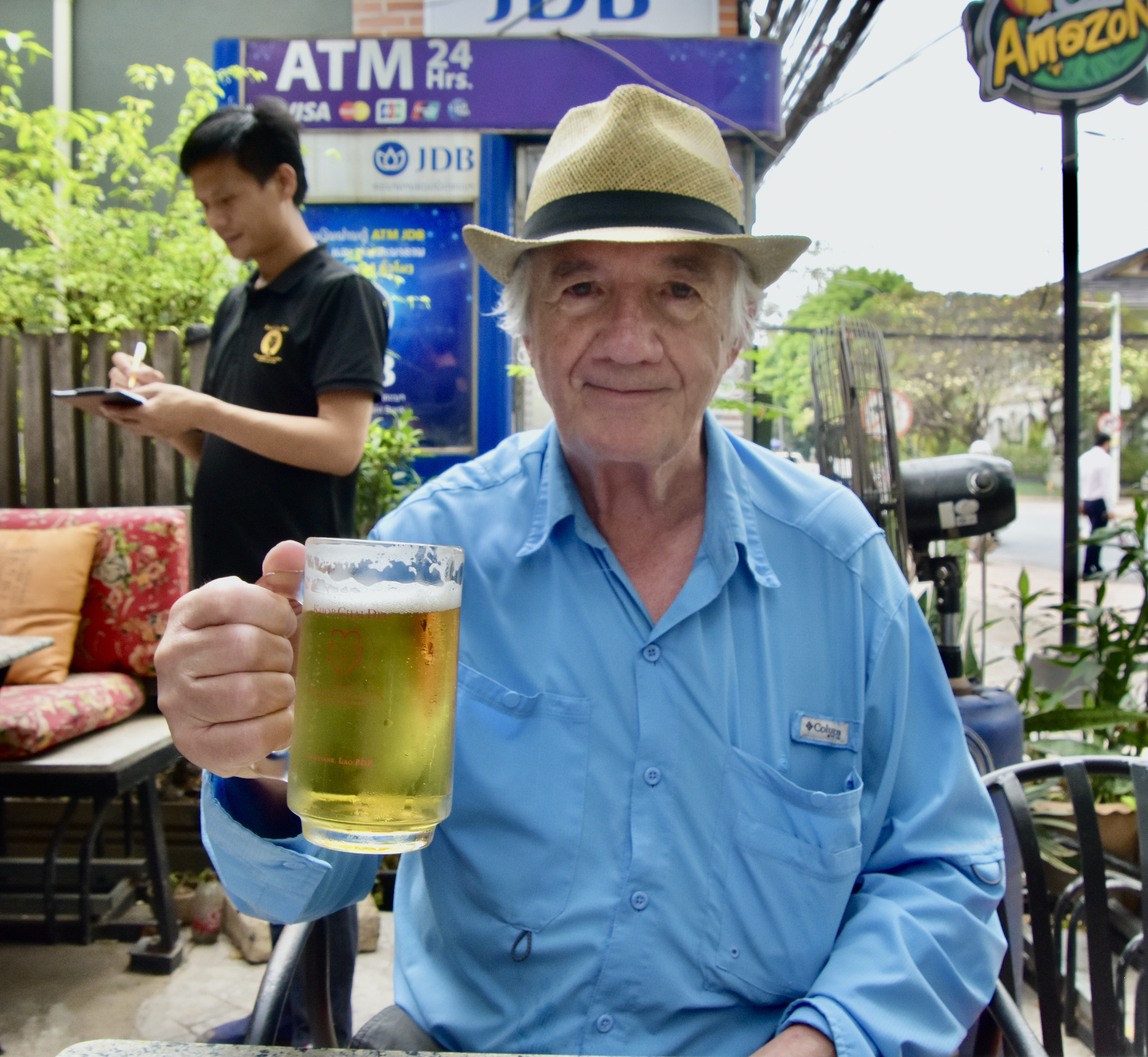
We had a few more quick stops on our tour of Vientiane before checking into the hotel. After the beer and sausages I did a double take on looking at this sign.
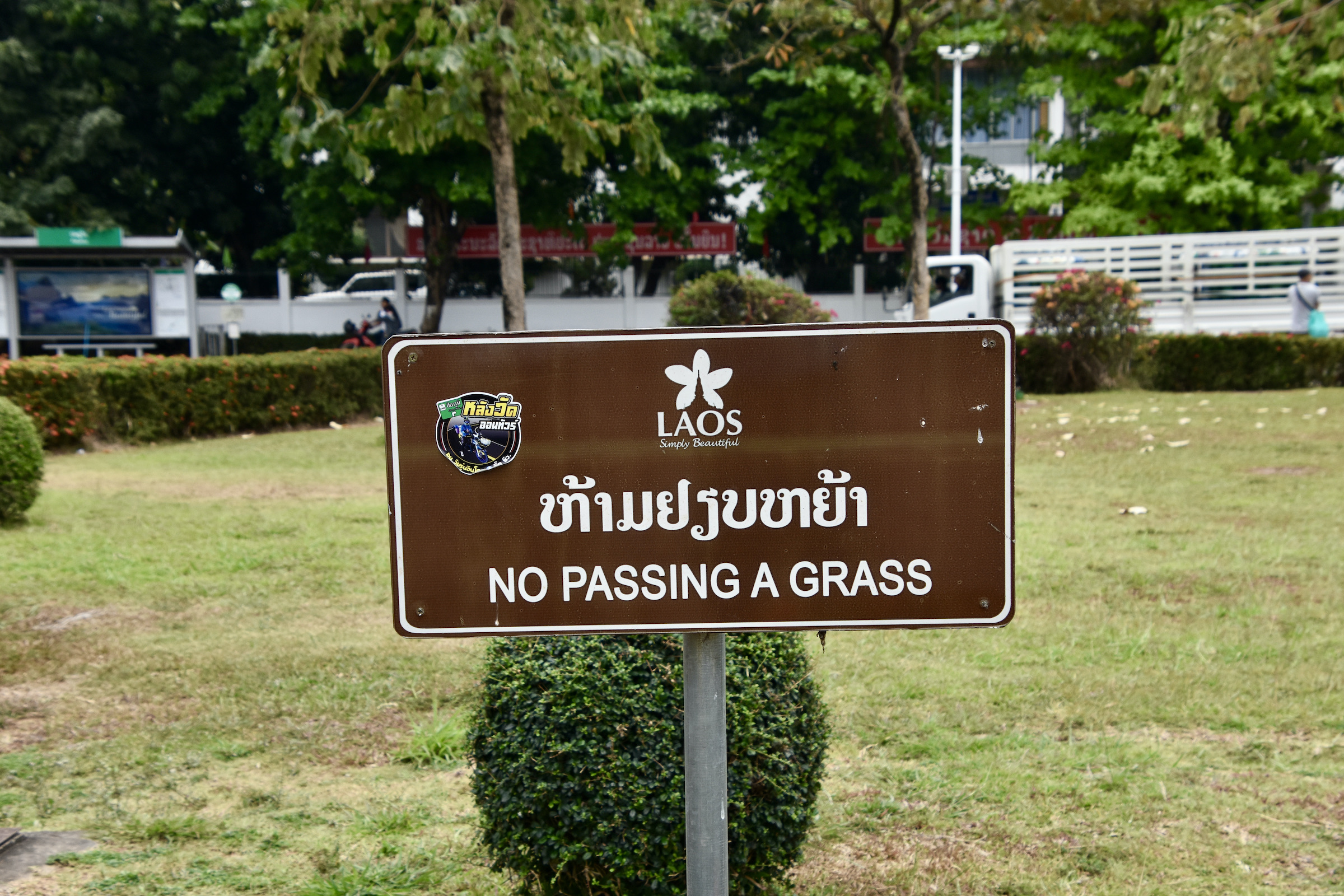
Patuxai – Vientiane’s Arch of Victory
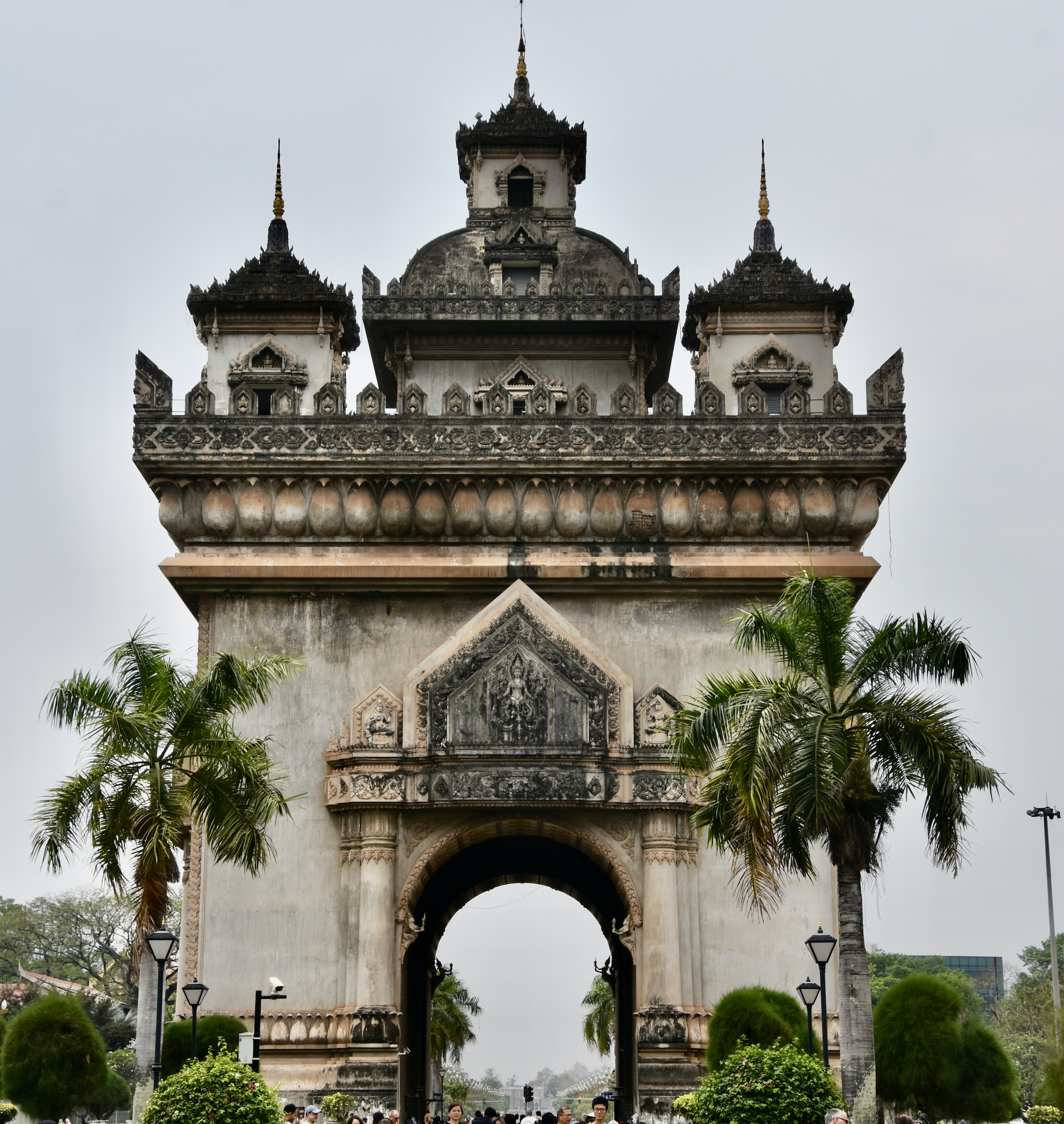
The most notable monument in Vientiane after the Great Stupa is the Patuxai or Arch of Victory, a relatively new structure commemorating the fight for independence from France after WWII. In a sort of in your face France gesture, it deliberately mimics the Arc de Triomphe, but in a distinctly Laotian style.
At the far end of the boulevard Lan Xang is the Presidential Palace. which is not open to the public and only used for ceremonial purposes.
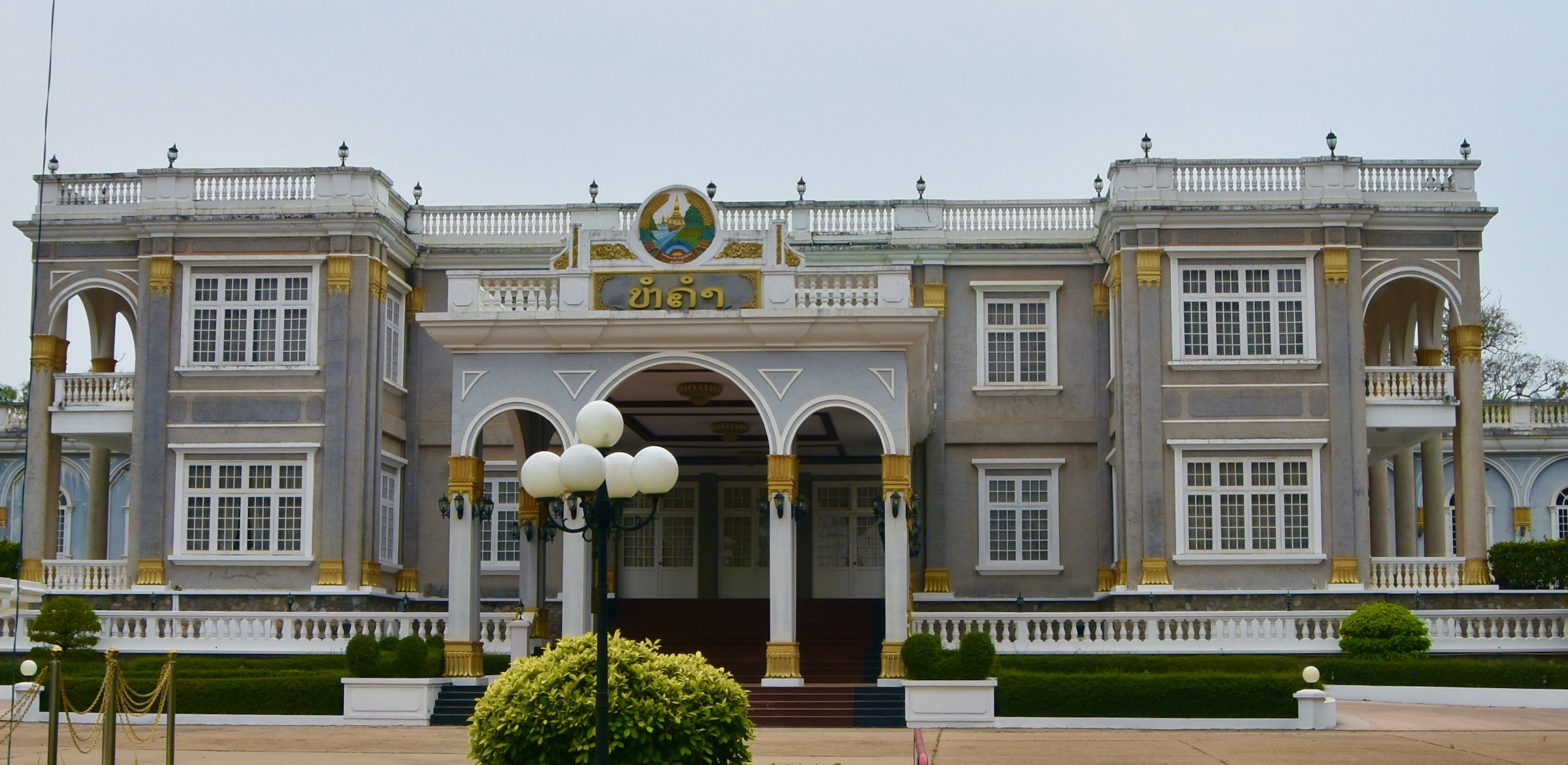
Lastly there is the National Assembly of Laos, the equivalent of our Parliament buildings or the U.S. Capitol building. Unlike the institutions housed in that latter building that seem to be perpetually in gridlock, things get passed in Laos because 158 out of 164 representatives belong to the Communist party. Whether anything actually gets done is another matter.
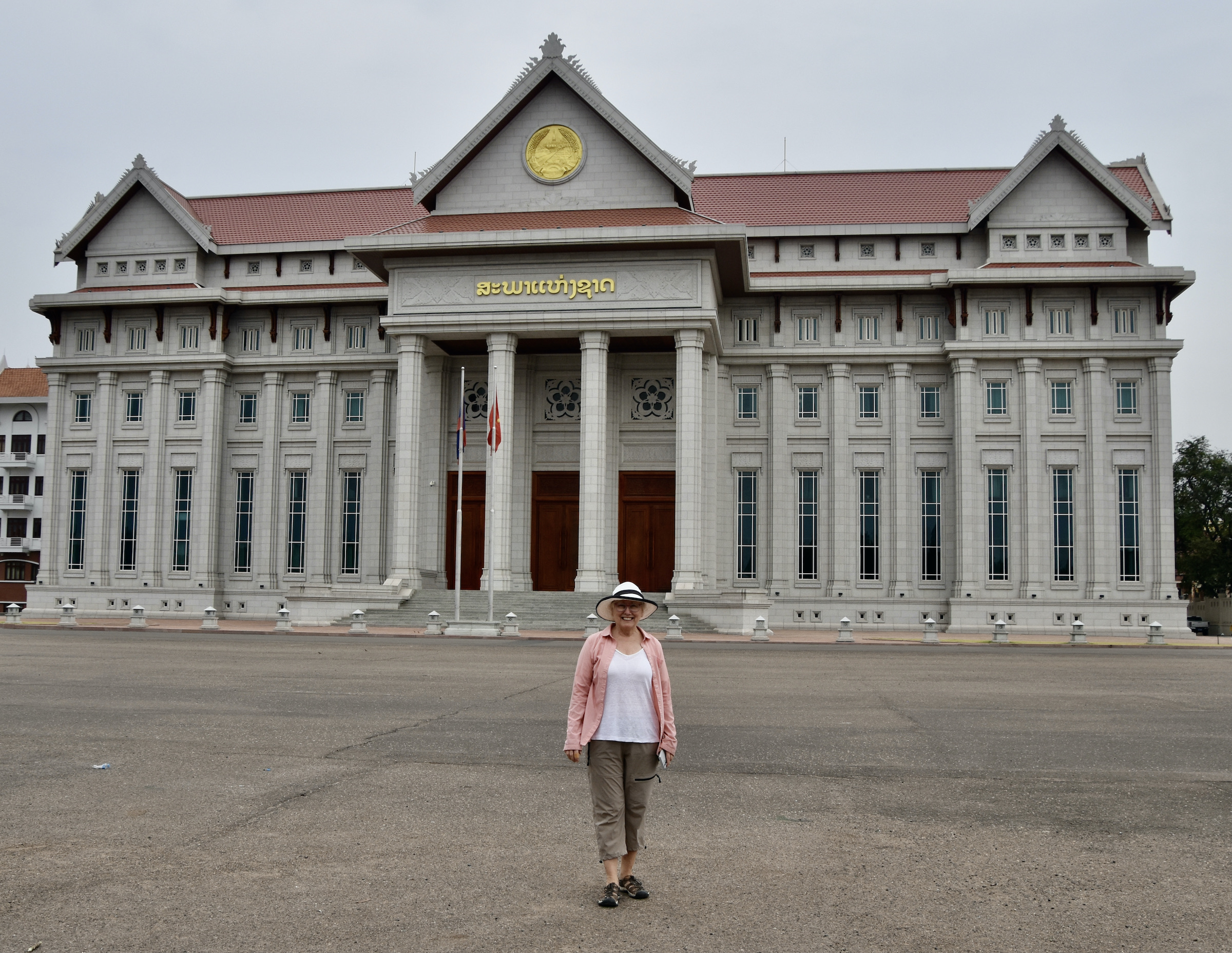
That concludes this post from Vientiane and our Adventures Abroad trip to the Land of a 1,000,000 Elephants. While we actually saw only one, it was a marvellous trip and a real opportunity to get an understanding of the challenges, risks and rewards of visiting a true third world country.
From Laos we move on to Vietnam where all but one from this trip will join us along with a few new adventurers. Hope you’ll come along too.


